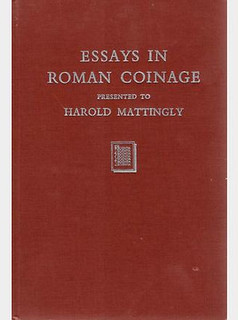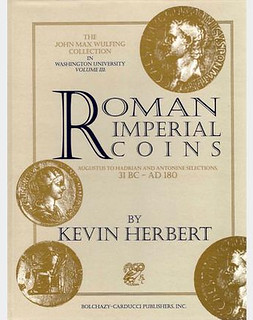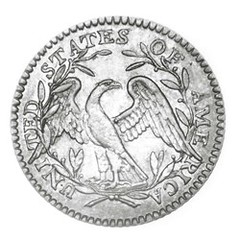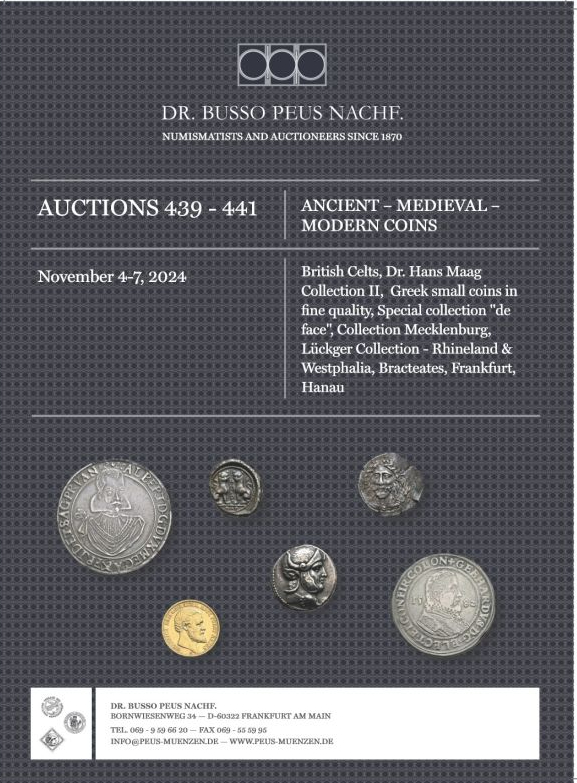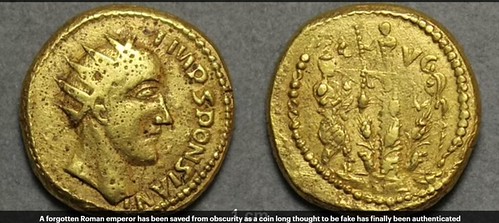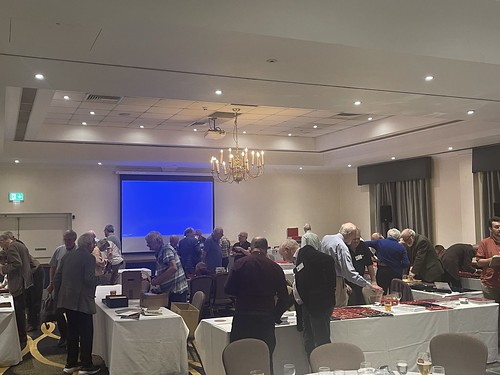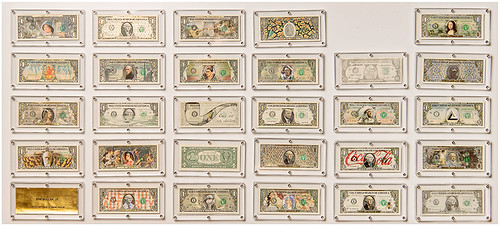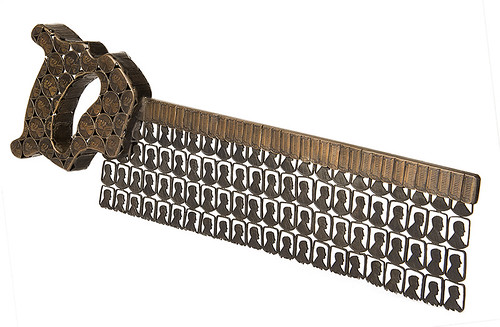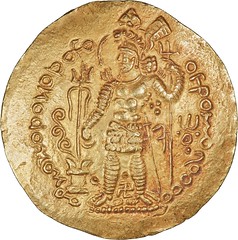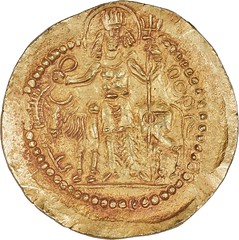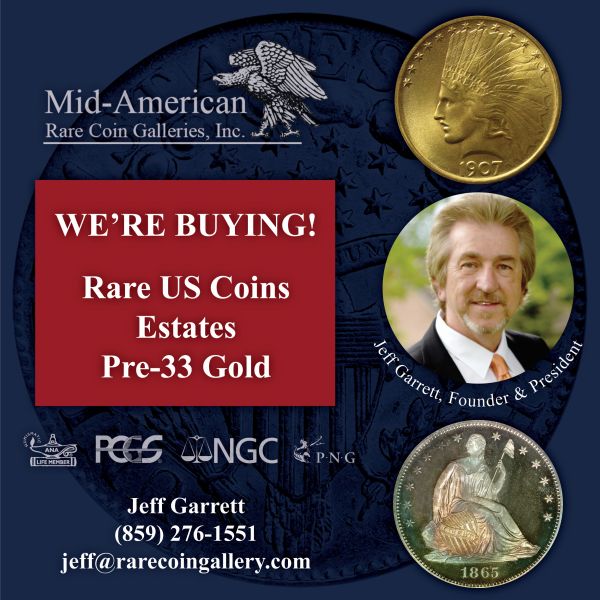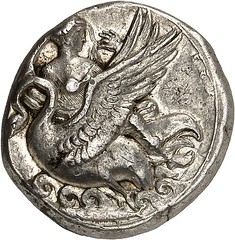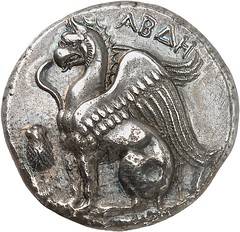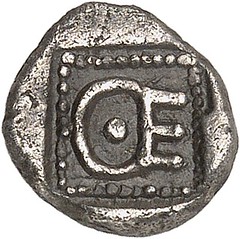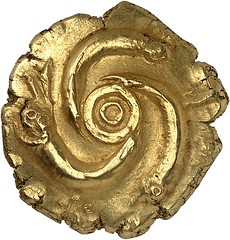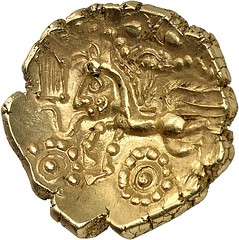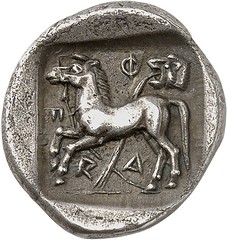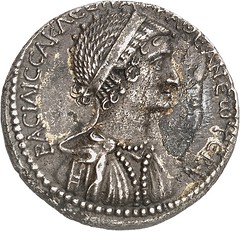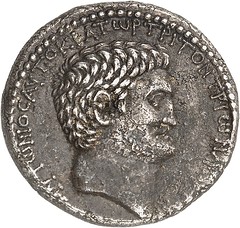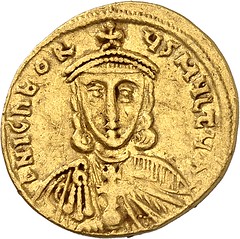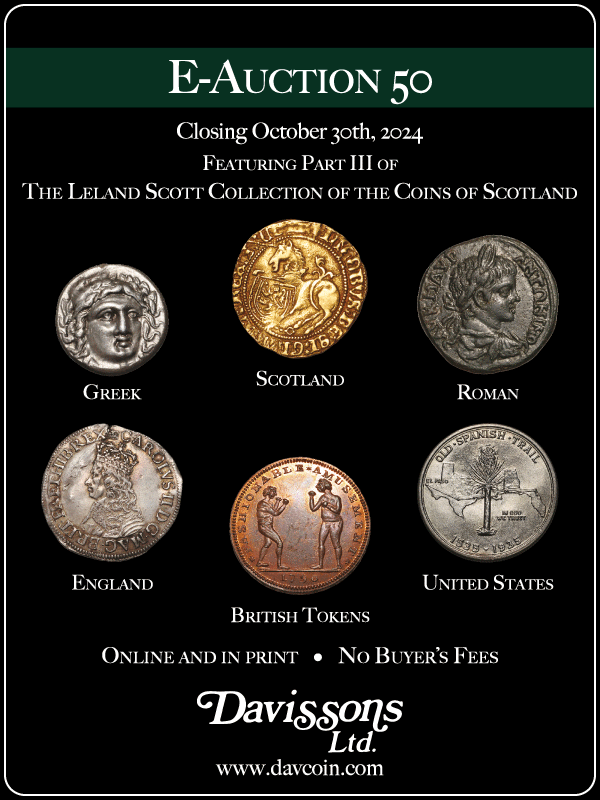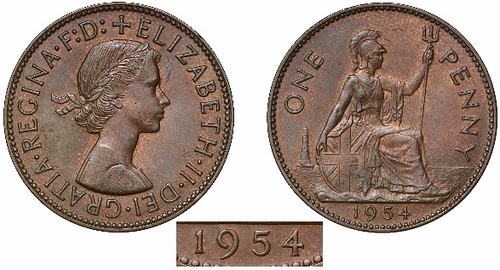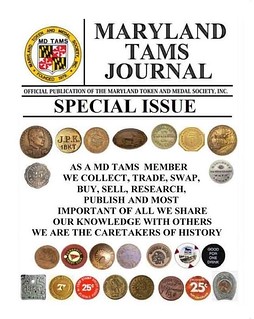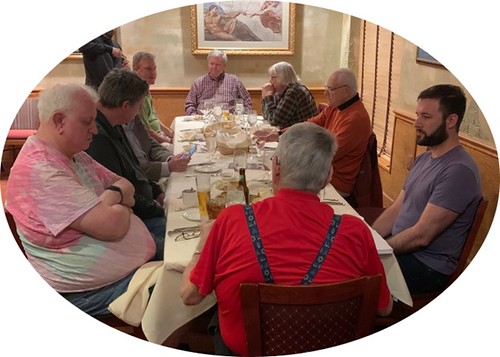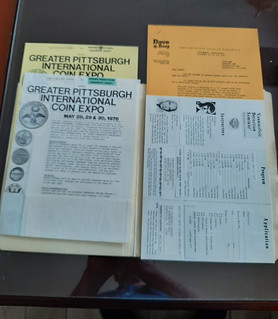
Visit our NBS Sponsors
About UsThe Numismatic Bibliomania Society is a non-profit association devoted to the study and enjoyment of numismatic literature. For more information please see our web site at coinbooks.org SubscriptionsThose wishing to become new E-Sylum subscribers (or wishing to Unsubscribe) can go to the following web page link MembershipThere is a membership application available on the web site Membership Application To join, print the application and return it with your check to the address printed on the application. Print/Digital membership is $40 to addresses in the U.S., and $60 elsewhere. A digital-only membership is available for $25. For those without web access, write to: Jeff Dickerson, Treasurer AsylumFor Asylum mailing address changes and other membership questions, contact Jeff at this email address: treasurer@coinbooks.org SubmissionsTo submit items for publication in The E-Sylum, write to the Editor at this address: whomren@gmail.com BUY THE BOOK BEFORE THE COINSale Calendar
|
- WAYNE'S WORDS: THE E-SYLUM OCTOBER 20, 2024
- KOLBE & FANNING WEB SALE NUMBER 3
- K&F BCD LIBRARY SALE, PART 2 HIGHLIGHTS
- NEW BOOK: BANKNOTES OF FINLAND
- COINSWEEKLY'S NEW NUMISMATIC DIRECTORY
- GUIDO CRAPANZANO (1938-2023)
- LOGAN-MCCLOSKEY PLATE COIN PHOTOS DIGITIZED
- THE EARLIEST SURVIVING CONFEDERATE NOTE
- NOTES FROM E-SYLUM READERS: OCTOBER 20, 2024
- 2024 BRITISH TOKEN CONGRESS REPORT
- VOCABULARY TERMS: PROOF BLANK, PROOF DIE
- HARRIET KEEFER RESTIFO (1911-2012)
- KELLEN HOARD INTERVIEW, PART TWO
- CLEMENTINE D'ORLEANS: FEMALE NUMISMATIST
- CULTURAL CURRENCY MONEY ART EXHIBIT
- ATLAS NUMISMATICS SELECTIONS: OCTOBER 20, 2024
- NUMISMAGRAM MEDAL SELECTIONS: OCTOBER 20, 2024
- HERITAGE AUCTION: INDIA PAST AND PRESENT
- THE SISI AND FRANZ NIGHTMARE WEDDING
- KUENKER AUCTION 416
- SOVEREIGN RARITIES WORKMAN COLLECTION
- STACK'S BOWERS BRUUN COLLECTION PART II
- WAYNE'S NUMISMATIC DIARY OCTOBER 20, 2024, PART ONE
- TOM'S NUMISMATIC DIARY OCTOBER 20, 2024
- WAYNE'S NUMISMATIC DIARY OCTOBER 20, 2024, PART TWO
- 1913 GOLD CARNEGIE HERO FUND MEDAL
- MASSACHUSETTS RAILROAD STOCK CERTIFICATES
- LOOSE CHANGE: OCTOBER 20, 2024
Content presented in The E-Sylum is not necessarily researched or independently fact-checked, and views expressed do not necessarily represent those of the Numismatic Bibliomania Society.
WAYNE'S WORDS: THE E-SYLUM OCTOBER 20, 2024
 New subscribers this week include:
John DeMarais and John Veech, courtesy of Larry Lee;
Carol Wolf, courtesy of Jim Glickman; and
Will Drakeley, courtesy of Garrett Ziss.
Welcome aboard! We now have 7,266 subscribers.
New subscribers this week include:
John DeMarais and John Veech, courtesy of Larry Lee;
Carol Wolf, courtesy of Jim Glickman; and
Will Drakeley, courtesy of Garrett Ziss.
Welcome aboard! We now have 7,266 subscribers.
Thank you for reading The E-Sylum. If you enjoy it, please send me the email addresses of friends you think may enjoy it as well and I'll send them a subscription. Contact me at whomren@gmail.com anytime regarding your subscription, or questions, comments or suggestions about our content.
This week we open with two numismatic literature sales, an obituary, notes from readers, updates from the Newman Numismatic Portal, and more.
Other topics this week include the earliest surviving Confederate note, the British Token Congress, Proof blanks and dies, Kellen Hoard, money art, fixed price and auction previews, Wayne and Tom's numismatic diaries, the S&S Numismatic Library, a gold Carnegie Hero medal, and stock certificates.
To learn more about Roman coinage, banknotes of Finland, Guido Crapanzano, Harriet Keefer Restifo, Kellen Hoard, Clémentine d'Orléans, skippets, Wildman Thalers, the 1954 Elizabeth II Currency Penny, and the birth of the Euro, read on. Have a great week, everyone!
Wayne Homren
Editor, The E-Sylum
KOLBE & FANNING WEB SALE NUMBER 3
Numismatic Booksellers Kolbe & Fanning have announced a new web sale closing October 23, 2024. Here's the announcement. -Editor
We will be holding the third of our new series of Web Sales of Numismatic Books on Wednesday, October 23, starting at 12:00 PM Eastern. Web Sale #3 focuses on inexpensive but useful books, catalogues and other publications on coins from all times and places. It will take place online, and all lots in the Web Sale will begin at a very low $10 opening bid.
Bidders may register for the sale, browse lots, and place absentee bids beginning immediately at bid.numislit.com.
Our Premier Auctions will continue to be held several times a year in the same format as usual. Customers who participate in those auctions will be able to register for our new Web Sales using their existing log-in information. New bidders will have to establish an account for online bidding by creating an account at bid.numislit.com or using the links to the app below.
Register early to bid online
Kolbe & Fanning use Auction Mobility as our third-party online bidding platform, which is separate from our retail site. Auction Mobility is an app-based platform allowing users the ability to participate in the sale through phones, tablets and computers. To register for the sale, bidders must go to
bid.numislit.com and sign up. Once you have set up an account, you may browse lots, place advance bids, or participate in the live sale online. Those wishing to participate on their devices can download the Kolbe & Fanning app through the Apple or Google Play Store.
Kolbe & Fanning Numismatic Booksellers LLC is a licensed and bonded auction firm in the State of Ohio, and our auctions are conducted by licensed auctioneers.
For more information, please see the Kolbe & Fanning website at numislit.com or email David Fanning at df@numislit.com. To register for the sale, go to bid.numislit.com. We look forward to your participation.
To bid and view lots, see:
Web Sale #3 of Numismatic Books
(https://bid.numislit.com/auctions/1-9PO9TJ/web-sale-3-of-numismatic-books)
K&F BCD LIBRARY SALE, PART 2 HIGHLIGHTS
Here are more highlights from the upcoming second sale of the BCD Library of ancient numismatics. -Editor
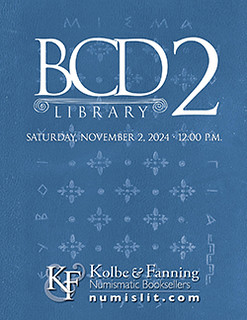 Kolbe & Fanning Numismatic Booksellers will be holding the second sale of material from the BCD Library on Saturday, November 2, beginning at 12:00 noon Eastern Time. The most extraordinary private collection of material on the coinage of antiquity that we have ever handled, the BCD Library features classic references, modern die studies of individual cities, descriptive catalogues of important collections, and much else. The online catalogue can be accessed at
bid.numislit.com.
Kolbe & Fanning Numismatic Booksellers will be holding the second sale of material from the BCD Library on Saturday, November 2, beginning at 12:00 noon Eastern Time. The most extraordinary private collection of material on the coinage of antiquity that we have ever handled, the BCD Library features classic references, modern die studies of individual cities, descriptive catalogues of important collections, and much else. The online catalogue can be accessed at
bid.numislit.com.
Some highlights of this first sale include:
Lot 58: Wolfram Hoepfner's extensive archaeological survey of the Pompeion, with the coins found at the site among the artifacts examined
Lot 70: the rare final edition of Charles Patin's excellent introduction to numismatics, a 1771 Spanish translation in a contemporary binding
Lot 156: the first edition (1735) of Hanthaler's Exercitationes faciles de numis veterum pro tyronibus, in a full calf period binding
Lot 173: Francesco Antonio Zaccaria's 1772 Istituzione antiquario-numismatica, the first edition of his fundamental work on coins and collecting
Lot 176: the massive catalogue produced by the Burlington Fine Arts Club for their 1904 Exhibition of Ancient Greek Art, in an Arts & Crafts style binding
Lot 192: the rare first volume, focusing on ancient coins, of Johann Heinrich Burckhard's catalogue of his own collection, Numophylacium Burckhardianum
Lot 228: over 200 original color photographs illustrating coins from the notable Collection P., focusing on the coinage of Thessaly
Lot 244: the first edition (1794) of Domenico Sestini's volume studying the Van Damme and Schellersheim collections, in a contemporary binding
Lot 391: The Copper Coinage of Thessaly, by Edgar Rogers (1932), a classic work cataloguing some 577 copper coins, including ones issued under the Romans
Lot 402: Nikolaos Petsalis's rare 1935 study of Euboean coins, in a charming BCD binding executed by Dionysis Valassis.
To read the earlier articles, see:
KOLBE & FANNING BCD LIBRARY SALE, PART 2
(https://www.coinbooks.org/v27/esylum_v27n40a02.html)
K&F BCD LIBRARY SALE, PART 2 HIGHLIGHTS
(https://www.coinbooks.org/v27/esylum_v27n41a04.html)
Register early to bid online
Bids may be placed via post, email, phone, as well as online. Kolbe & Fanning use Auction Mobility as our third-party online bidding platform. Auction Mobility is an app-based platform allowing users the ability to participate in the sale through phones, tablets and computers. To register for the sale, bidders must go to
bid.numislit.com and sign up. Once you have set up an account, you may browse lots, place advance bids, or participate in the live sale online. Those wishing to participate on their devices can download the Kolbe & Fanning app through the Apple or Google Play Store. The sale has also been listed on Biddr, NumisBids, and Numis24.
The printed catalogue has been mailed to all active customers on our mailing list. As international mail speeds have been inconsistent, we encourage our foreign clients to consult the electronic catalogue in case their printed catalogue does not arrive promptly. A PDF of the printed catalogue has been posted to our main website at numislit.com for those who prefer that format. Bids placed via post, email, or phone must be received by November 1, the day before the sale, in order for them to be processed. Advance absentee bids may also be placed at any time online at bid.numislit.com. Internet bidding will be available during the sale itself through the same platform.
NEW BOOK: BANKNOTES OF FINLAND
A free e-book published by the Bank of Finland covers the history of banknotes of the Grand Duchy of Finland. -Editor
Vom Zettel zum Geldschein: Deutsche Einflüsse auf das Design und den Druck von Banknoten im Großfürstentum Finnland
[From piece of paper to banknote: German influence on the design and printing of the banknotes of the Grand Duchy of Finland]
 The banknotes of the Grand Duchy of Finland, which was established in 1809, have been used as a starting
point in the description of the development of banknotes from a piece of paper to a trusted means of
payment. In the 18th and early 19th centuries, banknotes were commonly issued to finance wars or for some
other reason related to state finances. They often lost most of their value in the course of time due to
inflation. Numerous counterfeiting incidents heightened mistrust in them. Even though there were also
positive experiences with banknote issuance, it was not surprising that banknotes and paper money were
often viewed with disgust and treated with contempt and suspicion. They were seen as an inadequate
substitute for coins.
The banknotes of the Grand Duchy of Finland, which was established in 1809, have been used as a starting
point in the description of the development of banknotes from a piece of paper to a trusted means of
payment. In the 18th and early 19th centuries, banknotes were commonly issued to finance wars or for some
other reason related to state finances. They often lost most of their value in the course of time due to
inflation. Numerous counterfeiting incidents heightened mistrust in them. Even though there were also
positive experiences with banknote issuance, it was not surprising that banknotes and paper money were
often viewed with disgust and treated with contempt and suspicion. They were seen as an inadequate
substitute for coins.
During the 19th century, however, paper money was increasingly required to meet the needs of growing industrialisation and the liberalisation of trade. Banknotes were needed, in particular, for the larger payments required by commerce and industry. The authorities therefore took a number of steps to foster trust in banknotes. Three measures were of particular importance in this respect: the creation of a central bank monopoly over issuance, metal backing of issuance, first by silver and then by gold, and the development of the design and security of banknotes against new counterfeiting methods.
Starting from Johannes Gutenberg, the German role in the development of printing is well known. His innovation gained a foothold everywhere. What is less documented, however, is the German role in the design, engraving and printing of banknotes outside of Germany during their above-mentioned development phase. Even though the Grand Duchy of Finland was part of the Russian Empire, Germans had a role in every series of Finnish banknotes during the Russian period. This applied even to banknotes printed in St. Petersburg, as all of the parties contracted by the Bank of Finland in the printing process were of German origin.
During the first part of the 19th century, there was no significant banknote printing industry in Germany, and ordinary print shops and paper mills were mostly responsible for banknote production. However, as Germany evolved into a leading industrial power during the latter part of the century, the need for finance grew to unprecedented levels. Shares and bonds as well as issuance of non-interest-bearing debt instruments, banknotes, were used to meet financial requirements. This led to considerable investments in the security printing industry.
As a result of the liberalisation of trade, economic links developed, and German companies found customers abroad. Due to longstanding cultural relations, Finland was a fertile hunting ground in this respect. Printers educated in Germany were also encouraged to practice their profession abroad. A further important route by which Germans became involved with banknote production abroad was the role of journeyman. It was common for workers who had successfully completed an official apprenticeship qualification in a craft to gain experience abroad as part of their training. It was not exceptional that after this training the journeymen found a permanent position abroad.
These three channels of German influence on banknote design and printing were significant in the banknote history of the Grand Duchy of Finland in the 19th and early 20th centuries. Development in Finland was almost entirely based on foreign contributions, and the global nature of the industry and labour mobility were impressive.
It was only towards the end of the 19th century that the Bank of Finland established its own printing works, still using foreign, mostly German, designers, engravers and printers, however. Other countries also developed similarly. The book sheds light on this German role, which is sparingly addressed in the German-language literature.
The orientation of the Grand Duchy of Finland is also reflected in the themes and symbols of the banknotes, which grew in significance as nation-state thinking evolved. This became apparent in the growing role of the Finnish coat of arms at the expense of the Russian double-headed eagle, and in politically motivated symbols. A corresponding phenomenon appeared on German banknotes.
The significance of banknote design to the national identity has increased considerably in politico-sociological research over the last couple of decades. The general conclusion has been that the themes represent the agenda of the political decision-makers, with which they legitimise their actions. Several examples of the use of the same themes and design elements across borders, however, also highlight the role of designers and printing works in this respect.
After the independence of Finland in 1917, the Bank's own printing works took full responsibility for Finnish banknotes. This model was practised until the early phase of euro banknote production, at which time the Bank of Finland turned once again to Western European know-how, and banknote printing interestingly turned full circle. The Bank began to use many of the same printing works as during the second half of the 19th century and the early 20th century, even though most of the companies had in the meantime acquired new names due to political changes or for commercial reasons.
The book is written by Antti Heinonen and published by the Bank of Finland and Giesecke+Devrient Stiftung Geldscheinsammlung on their respective websites. The author has had a long international career in the field of banknotes, having chaired, for example, the Banknote Ethics Initiative (BnEI) and the Executive Committee of the Central Bank Counterfeit Deterrence Group (CBCDG) and being the first Director, Banknotes at the European Central Bank (ECB). Prior to joining the ECB in 1998, Heinonen was the Chief Cashier of the Bank of Finland.
To read the complete article, see:
https://www.suomenpankki.fi/globalassets/bof/fi/julkaisut/muut_julkaisut/vom-zettel-zum-geldschein-english-summary.pdf
To read the complete book, see:
https://www.suomenpankki.fi/globalassets/bof/fi/julkaisut/muut_julkaisut/bank-von-finnland-vom-zettel-zum-geldschein-compressed.pdf
COINSWEEKLY'S NEW NUMISMATIC DIRECTORY
To mark its 15th anniversary, CoinsWeekly launched a new feature on 19 September 2024. Thousands of numismatic locations are now available at www.numismatic-directory.com. -Garrett
We all know the problem: you travel to a foreign city and want to explore its numismatic highlights, but you do not know where these numismatic highlights are. It is extremely frustrating to return home and find out that an interesting coin dealer or an exciting numismatic exhibition was just around the corner. CoinsWeekly has launched a new tool to solve this problem: the Numismatic Directory. The Numismatic Directory collects addresses of numismatic highlights all over the world and organises them geographically. You can find the Numismatic Directory in English at https://numismatic-directory.com/en/ and in German at https://numismatic-directory.com/.
What You Can Currently Find in the Numismatic DirectorySo far, the Numismatic Directory presents the following categories:
- Coin dealers & auction houses
- Coin shows & coin fairs
- Numismatic service providers
- Museums & coin cabinets
- Numismatic sights
- Academic institutions
- Associations
- Mints
- Central banks
Thanks to the co-operation of Numista and Howard Berlin, better known as the Numismatourist, around 3,500 coin dealer addresses and around 200 commented entries of numismatic museums are available right from the start. Our team is constantly researching and adding new addresses. We are currently working on the most important numismatic metropolises: Vienna has already been published; Madrid and Hamburg will follow over the next few weeks. Frankfurt, Berlin, Chicago, London, Munich and Osnabrück / Münster are in the pipeline.
I Would Like to Be Featured on the Numismatic Map!Anyone who falls into one of the above-mentioned categories can be listed in the Numismatic Directory. For non-profit organisations, even the extended entry with text and images is free of charge. Please contact Aleksandar Brzic at numismatic-directory@muenzenwoche.de.
The Numismatic Directory is financed by extended entries and advertising from commercial sponsors. If you are interested, please contact Andrea Pancheri at anzeigen@muenzenwoche.de.
How Can the Numismatic Directory Grow?
We know that the CoinsWeekly team is too small to explore the whole world. That is why we are looking for Coin Scouts to help us fill the gaps in the numismatic map. Find out more at https://new.coinsweekly.com/news-en/become-a-coin-scout/
To view the Numismatic Directory, see:
THE NUMISMATIC DIRECTORY
(https://numismatic-directory.com/en/)
GUIDO CRAPANZANO (1938-2023)
An article by Roberto Ganganelli and Gerardo Vendemia in volume 63. No. 3 of the IBNS Journal is a remembrance of former International Bank Note Society President Guido Crapanzano. With permission, we're republishing it here. -Editor
Another historical figure of Italian numismatics has left us: Guido Crapanzano passed away in Milan on December 10, 2023; for paper money enthusiasts, not only Italians, he has always been "the professor".
Guido Crapanzano – born in 1938, originally from Brescia and Milanese by adoption – was a point of reference for those, collectors or scholars, who have the banknotes of yesterday and today as the object of their interest.
Guido Crapanzano began collecting and studying banknotes during high school. However, one should not think that he was a "model student", at least not in the classic sense: in fact, he cultivated, in parallel, a passion for music and cinema, so much so that he soon became "Guidone" of Adriano Celentano's Clan, and tried his hand at acting in some successful "musicarelli". Not to mention, together with his group, his role as a supporter of the Beatles during their concerts in Italy and of the Rolling Stones in Greece.
In the following years – in the name of an ever multifaceted activity – he opened a music club and an advertising agency, also dedicating himself to editorial and cinematographic productions, not to mention his activity as an antiques dealer and art gallery owner. His passion for neurological research and the achievement of the title of Ingenieur Cybernetique also date back to the 1970s. Following his vocation for neuroscience, he went to the USA – between 1973 and 1978 – attending courses at the Mental Research Institute in Palo Alto where, in 1978, he became a researcher. In 1982 he also obtained a doctorate in Communication Sciences.
Between 1974 and 2001, "the professor" spent several months a year in the USA where, in addition to neuroscience, he devoted himself to numismatics, collaborating with the American Numismatic Association (Crapanzano was the only Italian to receive the Presidential Award) and the Smithsonian Institution.
Between 1975 and 1980 he also carried out intense numismatic activity in Italy, Europe and South America as a partner of the company Kunst Münzen AG of Lugano. As an expert on paper money, he was also president of the International Bank Note Society and was named honorary member of the Italian Academy of Numismatic Studies.
 Hundreds of articles for magazines such as "Cronaca Numismatica" and "Il Giornale della Numismatica" bear his name, as well as fundamental volumes such as "Soldi d'Italia" (catalogue of the 1996 Parma exhibition, more than 4,000 copies sold), the two volumes of catalogue "La cartamoneta Italiana", "Corpus Notarum Pecuniariarum Italiae", the monograph "Trento Cionini, il maestro della banconota" (published in 2007) and "Amadeo Pietro Giannini. The banker who invested in the future", a biography of the great Italian-American banker published in 2017.
Hundreds of articles for magazines such as "Cronaca Numismatica" and "Il Giornale della Numismatica" bear his name, as well as fundamental volumes such as "Soldi d'Italia" (catalogue of the 1996 Parma exhibition, more than 4,000 copies sold), the two volumes of catalogue "La cartamoneta Italiana", "Corpus Notarum Pecuniariarum Italiae", the monograph "Trento Cionini, il maestro della banconota" (published in 2007) and "Amadeo Pietro Giannini. The banker who invested in the future", a biography of the great Italian-American banker published in 2017.
A consultant to the Bank of Italy since 1996, he has studied and enriched the numismatic heritage of the institute in Via Nazionale and has held conferences in Italy and abroad, collaborating with museums such as the British Museum in London, the Smithsonian Institution in Washington, the Hermitage in St. Petersburg and the Vatican Medagliere.
In 1996 he was appointed to collaborate with the ECB in the creation of the euro, representing Italy in the jury for the selection of the banknote designs. Since 1993, and until 2012, as a consultant to the institute, Guido Crapanzano has organized successful exhibitions in Vicenza numismatics, exhibiting series and rarities from both public and private collections.
Between 2002 and 2014 he was also the television face of numismatics, participating as a guest in more than 150 broadcasts on public and private channels. In 2002, the President of the Republic, Carlo Azeglio Ciampi, awarded him motu proprio the insignia of Grand Officer of the Order of Merit of the Italian Republic. And in 2005, the Italian Foundation in the Americas, for his "rediscovery" of the figure of the founder of the Bank of America, Amadeo Peter Giannini, awarded him the Miami Award.
Thanks to him, a generation of passionate collectors, scholars and professional traders in the sector of paper money and numismatics in general has grown up in Italy. A person of vast culture, always open to dialogue – even and above all with neophytes – "the professor" was able to create ways and forms – original and unprecedented, sometimes even pop – to communicate the beauty, the historical and symbolic value of paper money, highlighting the many aspects of correlation between banknotes and human events, and valorizing heritages of knowledge otherwise destined to the oblivion of archives.
In Vicenza Numismatica, in 2007, Guido Crapanzano donated to the collections of the Bank of Italy a very rare 1000 lire from the Piedmontese Royal Finances, the first Italian banknote
We could also define Guido Crapanzano as a "banknote archaeologist", because, thanks to a lifetime of research, he has revealed many unpublished notes and rediscovered "lost" banknotes and projects, press essays, but above all placing each of these fragile, precious and beautiful finds of economic modernity in the evocative framework of History.
Finally, we would like to underline that, although Guido Crapanzano has always appeared, especially in the numismatic field, as an authentic "authority", those who knew him remember him more willingly for his authoritativeness. For the writers of this tribute, "the professor" has played the role of the friend Guido, of the mentor, and his teachings are jealously and gratefully preserved within us. Just as the time spent together will always remain in the memory, always welcomed with affection and a smile, in the house in Milan that he shared for many years with his beloved wife Sandra. To her we express our sympathy, which we know is shared by all those who have had the fortune and privilege of truly knowing Guido Crapanzano.
The text was previously published in Italian language in "Cronaca Numismatica".
For more on the International Bank Note Society, see:
https://www.theibns.org/
Also republished with permission is this excerpt from Steve Feller's article in the October 13, 2024 issue of the MPC Gram (Series 25 No. 2616). Thanks. -Editor
 Guido Crapanzano passed away last December at the age of 85. This was reported to the
numismatic community by Pam West in her president's report in the I.B.N.S. Journal. Guido was
larger than life, indeed he was a force of nature; his accomplishments are legion.
Guido Crapanzano passed away last December at the age of 85. This was reported to the
numismatic community by Pam West in her president's report in the I.B.N.S. Journal. Guido was
larger than life, indeed he was a force of nature; his accomplishments are legion.
He was THE Italian bank note collector. He was president of the I.B.N.S. He wrote the standard book on Italian paper money and was a major contributor to World War II Remembered.
He was a literal rock star musician and went by the name Guidone. He performed with many world-famous groups including the Beatles.
 He was flamboyant, generous, spirited, and genuinely nice. In numismatics he was well-known
for leading the celebration of the I.B.N.S.'s 40th anniversary in 2004. Celebrations were held
around the numismatic world. In The U.S. it was at Memphis in June. What a party it was. Food,
stories, a free reverse raffle—wouldn't you know it as the last number drawn for a 1000 federal
reserve note a silence fell over the crowd. MC Joe Boling tried the number a second time. Only
then did he check his pocket and his ticket and, lo and behold, he was the winner!
He was flamboyant, generous, spirited, and genuinely nice. In numismatics he was well-known
for leading the celebration of the I.B.N.S.'s 40th anniversary in 2004. Celebrations were held
around the numismatic world. In The U.S. it was at Memphis in June. What a party it was. Food,
stories, a free reverse raffle—wouldn't you know it as the last number drawn for a 1000 federal
reserve note a silence fell over the crowd. MC Joe Boling tried the number a second time. Only
then did he check his pocket and his ticket and, lo and behold, he was the winner!
LOGAN-MCCLOSKEY PLATE COIN PHOTOS DIGITIZED
The latest addition to the Newman Numismatic Portal is a gallery of Logan-McCloskey plate coin photos. Project Coordinator Len Augsburger provided the following report. -Editor
Logan-McCloskey Plate Coin Photos Digitized
In 1998, Russ Logan and John McCloskey published Federal Half Dimes 1792-1837, which expanded on the previous work by Daniel Valentine. This work entailed a significant effort, and today "LM" numbers are the standard for attributing early half dimes. NNP has recently digitized the (pre-Bust) LM plate coins from a set of photographic prints. This set includes 32 die varieties and was photographed by Tom Mulvaney
Image: 1795 LM-1 half dime
Link to Logan-McCloskey plate coin images on Newman Portal:
https://nnp.wustl.edu/library/imagecollection/518109
THE EARLIEST SURVIVING CONFEDERATE NOTE
Steve Feller submitted this note about a great banknote in his collection, inspired by last week's article about Confederate rarities in an upcoming Stack's Bowers sale. Thank you! -Editor
The following is from an article I wrote for Paper Money regarding the earliest known Confederate note. The article was A Great Note Finally Obtained: The Earliest Surviving Confederate Note (Paper Money LV (6) (Whole Number 306) 443-447 (2016)). The note is in my collection. It too is a Type 3 $100 CSA note from a stack's Bowers auction.
Stack's Bowers described this note as follows:
T-3. Confederate Currency. 1861 $100. PCGS Fine 12 Apparent. Repaired Splits, Upper Left Corner Replaced.
No. 6, Plate A. This is the lowest recorded serial number of any T-3 according to the census in "Collecting Confederate Paper Money" by Pierre Fricke. It is also the third lowest serial number of all recorded Montgomerys. This example was issued from New Orleans on April 20th, 1861 by N.J. Delaplaine. The note was later redeemed at the Custom House in New Orleans where the sum of $100.55, being principal and interest, was paid to the holder as seen by the large stamp on the back. A large stamp cancellation is seen on the face reading "CANCELLED BY F.H. HATCHER, COLLECTOR N. ORLEANS." The green tint remains strong on this note despite the level of circulation and repairs mentioned by the grading service. Bold blue stamped serial number 6s are seen at left and right making this a noteworthy yet affordable key note for the Confederate type set.
From the Old Virginia Collection.
Certainly, this is a fair description but it is by no means complete. Let us delve deeper. An invaluable resource to any collector of Confederate States notes is the small book Register of the Confederate Debt by Raphael P. Thian first published in 1880 under a longer title but reprinted with the shorter title by Quarterman Press in 1972. In it the author lists every serial combination with signers that were known to the author from the so-called Rebel Archives held in Washington, D.C. Included in this are the serials signed for the Montgomerys as well as the dates that these notes were signed. Below is a scan of the relevant section of Thian's book:
We see that the very first signing of Confederate notes took place on April 5, 1861-the same date that is on my note. On that date just nineteen T-3s and five T-4s were signed. This was a modest start for the new nation and summed to just $2150 in face value. By the end of the war the total would be on the order of billions of dollars issued. It is easy to confirm that my newly obtained note squarely falls in the beginning part of that very first day's signed lot of notes.
Furthermore, according to Pierre Fricke's census published in his recent book on Confederate Notes, Collecting Confederate Paper Money: Field Edition 2014 only three notes from the first day of signing have survived. These are serials 6, 12, and 16 of T-3. No T-4 notes are known to have survived from the first day of signing. Thus, my note illustrated above is the lowest surviving serial note from the first day the Confederacy signed and issued its currency notes!
As a postscript the Montgomery notes given in the E-Sylum piece by Stacks' Bowers were signed as follows: April 25, 1861 for the serial 54 Type 2 $500 and May 4, 1861 for the serial 682 Type 3 $100 note as maybe seen in the page from Thian's book or from the notes themselves (not visible in the article). Thus, the two Montgomery notes shown by Stacks' Bowers were signed just 9 days apart which may explain why they were together in the first place.
To read the earlier E-Sylum article, see:
CONFEDERATE BANKNOTE RARITIES
(https://www.coinbooks.org/v27/esylum_v27n41a29.html)
NOTES FROM E-SYLUM READERS: OCTOBER 20, 2024
Nebraska Numismatist Articles Sought
Central States Numismatic Society President Mitch Ernst writes:
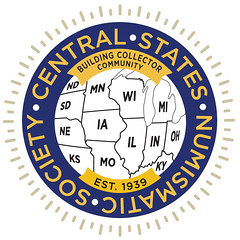 "As you may know, we at Central States have begun an exciting program of bringing one of our thirteen states into the spotlight each year at our convention. We call it the "State Showcase" program. Well, 2025 will be Nebraska. We are looking for articles about some of Nebraska premiere numismatic personalities particularly Aubrey Bebee and J. Hewitt Judd, both of whom are from Nebraska. Both making and having an important impact on the hobby. We are looking for articles!
"As you may know, we at Central States have begun an exciting program of bringing one of our thirteen states into the spotlight each year at our convention. We call it the "State Showcase" program. Well, 2025 will be Nebraska. We are looking for articles about some of Nebraska premiere numismatic personalities particularly Aubrey Bebee and J. Hewitt Judd, both of whom are from Nebraska. Both making and having an important impact on the hobby. We are looking for articles!
"If any of your readers have or can share a biographical article about either or both of the aforementioned Nebraska Numismatic dignitaries, may I request that they submit their proposal to our editor, Barbara Gregory for inclusion in our magazine The Centinel? Please email editor@csns.org. Thank you!"
Great project. Can anyone help? -Editor
For more information on the Central States Numismatic Society, see:
https://www.csns.org/
Vocabulary Word: Skippet
Scott Miller writes:
"Regarding your inquiry about the medal in the box with the Louisiana Purchase, it is actually a skippet, or box used to house a wax seal. The giveaway is the cords attached to it."
Well I'll be - I learned a new word! I wasn't aware of that, but it makes sense given the fragility of wax seals. Thanks! Scott provided these examples. -Editor
Scott adds:
"Here is another view of the box and skippet from the National Archives website"
Louisiana Purchase Treaty (1803)
(https://www.archives.gov/milestone-documents/louisiana-purchase-treaty)
and...
"Here is an example of a grant of arms and nobility with the skippet opened to show the wax seal."
Emperor Franz Joseph I of Austria Grant of Arms and Nobility Signed....
(https://historical.ha.com/itm/autographs/non-american/emperor-franz-joseph-i-of-austria-grant-of-arms-and-nobility-signed/a/6116-49163.s)
To read the earlier E-Sylum article, see:
DIGITIZING THE NATIONAL ARCHIVES
(https://www.coinbooks.org/v27/esylum_v27n41a31.html)
US Mutilated Coin Program
Felix Bronstein passed along these articles on the US Mutilated Coin Program. Thanks. -Editor
To read the complete articles, see:
CMN September 2024 by Reconnaissance International - US Mutilated Coin Program Permanently Abolished
(https://issuu.com/reconnaissance/docs/cmn-v3-n9-sept-2024-9mdmm)
Time, expense lead U.S. Mint to stop coin redemptions
(https://www.coinworld.com/news/us-coins/time-expense-lead-u-s-mint-to-stop-coin-redemptions)
ReMA and Members Urge U.S. Mint to Reinstate Mutilated Coin Program
(https://www.remanews.org/rema-and-members-urge-u-s-mint-to-reinstate-mutilated-coin-program/)
To read the earlier E-Sylum article, see:
LOOSE CHANGE: SEPTEMBER 29, 2024 : Mint Ends Mutilated Coin Exchange Program
(https://www.coinbooks.org/v27/esylum_v27n39a31.html)
Thoughts on Sponsianus
Thomas Lovelace writes:
"A while ago, I meant to submit some comments about a potential Roman coin of Sponsianus. I suppose better late than never.
"Based on everything that I have seen so far, I do not believe that Sponsianus was a Roman Emperor. I do not believe that the item is a Roman coin. I do, however, believe that the item was minted in Dacia around 270CE. I believe that the item was made as a wedding gift by a local jeweler for a friend.
"I base this on the following observations. I had read that the metallurgy is consistent with the impurities from the Dacia gold mines around 270CE. When I do a Google translate from Latin to English for spons, sponsi, sponsia, etc. the results are betrothed, bridegroom, spouse. The figure to the left of the honorific column seems to be projectile vomiting on the column (not honoring Rome). The weight is not consistent with a Roman coin of that time. The style is different. If someone were making a fake, the reverse type would not be consistent with what would be expected at the purported time of Sponsianus."
Thanks. Interesting option. What do readers think? -Editor
To read the earlier E-Sylum articles, see:
COIN OF SPONSIAN IS GENUINE. OR IS IT?
(https://www.coinbooks.org/v25/esylum_v25n48a22.html)
IS SPONSIAN REAL?
(https://www.coinbooks.org/v25/esylum_v25n50a20.html)
ANOTHER SPONSIAN ARTICLE
(https://www.coinbooks.org/v26/esylum_v26n04a19.html)
No Coins Consigned by Randy Bachman
Heritage Auctions Senior Vice President and Partner Sarah Miller writes:
"To answer your question, these are some lots sold by Heritage from the Randy Bachman collection. No coins—just entertainment memorabilia. Besides the auction mentioned in the video, there were consignments of guitars, signed items, etc."
Thanks. So maybe the BTO guitarist isn't a celebrity numismatist. -Editor
To see some of the Bachman-consigned lots:
https://entertainment.ha.com/c/search/results.zx?
term=bachman&si=2&dept=2182&archive_state=5327&sold_status=1526%7E1524
&auction_name=7004&auction_year=2009&mode=archive
&page=204%7E1&ic=KeywordSearch-A-K-071316
https://entertainment.ha.com/c/search/results.zx?
dept=2182&sold_status=1526~1524&archive_state=5327
&mode=archive&auction_name=7006&auction_year=2009&consignor_no=30
To read the earlier E-Sylum article, see:
VIDEO: RANDY BACHMAN SELLS HIS COLLECTION
(https://www.coinbooks.org/v27/esylum_v27n41a12.html)
2024 BRITISH TOKEN CONGRESS REPORT
Jeff Rock attended the recent British Token Congress and filed this report for our readers. Thank you! -Editor
The 42nd annual British Token Congress took place in Northampton, a short hour-long train ride outside of London on October 4-6 2024. This is one of the most unique events in numismatics – as well as one of the biggest bargains! From Friday afternoon until Sunday afternoon the attendees were treated to fifteen different talks, ranging from 10 minutes to just under an hour, on all types of token topics. Talks are usually heavy on the 17th century issues, but this year saw a surprising amount of 18th century content, the ever-popular Conder token series that has captivated American collectors for decades. There was even a talk that veered into colonial American coinage, an excellent discussion on the Somers Islands "hogge money," which was recorded and will be made available to collectors.
Talks often have cheeky titles, which make you look forward to hearing them! This year had talks billed as "Sausages and Plaster," "Nice Glass of Red, Anybody?," "From Newgate Prison To Chicago," "A Round Tour of the Square," "Magic, Superstition and the Tokens that Never Were," and "17th Century School Tokens – You'd Better Learn or Else." In addition, there were other interesting talks on a variety of subjects: female issuers of 17th century tokens – in an era when women could not hold property or had many rights at all once married, there were a surprising number of them who issued trade tokens; a surprising American connection to the tokens issued in Dundee Scotland based on the architectural drawings of James Wright; a look at the tokens that depict the London City Gates; an introduction to John Freeth, the Birmingham Poet who was memorialized on tokens, and more.
While many coin shows feature talks, they are often little more than an auxiliary to the main action of a bourse floor and auction. For Token Congress that script is flipped, and the talks are the main reason for attending – and around 100 collectors from the UK, Europe, and double-digit representation from the US signed up for the experience. For the ridiculously low price of 220 pounds (about $285 at the time I booked), you get two nights in a rather nice Hilton Hotel, all your meals (dinner Friday night, breakfast lunch and dinner on Saturday, and breakfast on Sunday, with an option to add lunch that day as well), and several tea and coffee breaks, because it is England after all. Several kegs of beer were donated by Baldwin's, and a two-pound donation got you a pint, and to add to the alcohol mix, Noonan's donated both red and white wine to every table at the Saturday night dinner – while the hotel bar offered still further options to tipple. All attendees received a lavish full-color 46 page program which contained some excellent articles which have not been published anywhere else.
In addition to all the talks, there is an auction on the Friday night, which this year had over 250 lots of tokens and books up for live bidding, with tokens from the 16th to 20th centuries, realizing from just a few pounds to just over 100 pounds – prices that were often far less than you would have paid for the same things at a public auction or dealer's price list, and the literature lots went especially cheap (I was contemplating buying another suitcase and lugging as many as I could back home, but contented myself with just one 18th century book). On Saturday night there is a gala dinner, followed by a bourse, with a dozen or so dealers and collectors set up to tempt you to trade cash for tokens. This is my 13th year attending and I can honestly say that there have been few years where I did not find enough interesting material at the auction or on the bourse to justify the trip, and some of the things I was able to purchase were items that I would never otherwise had seen.
Token Congress has been purposely fitted to the "sweet spot" between the large Coinex show in London the weekend before, and any token auction in London the following week – this year there were two major token auctions, by both Baldwin's and Noonan's, with a couple thousand tokens crossing the block on two consecutive days, plus a smaller auction by St. James.
A trip of ten days or so would thus allow you to not only do Token Congress, attend auctions, and a major coin show, but also allow for some sightseeing time in London or elsewhere, while extending it to two weeks gives you even more time to explore. Token Congress also happens after the peak travel season, meaning airfare and hotel rooms are far less-expensive than they would have been a month or two earlier – but still early enough that the weather is decent, with cooler days and nights, but not yet cold.
Very few people who have attended once have stopped there – indeed, most come back year after year because the talks each year are always interesting and different, they look forward to seeing friends they've made (who usually collect the same stuff they do), as well as the thrill of adding things to their collection.
While exact dates have not been set yet for 2025, it is likely to be the last week of September, or the following week; because of inflation everywhere, the cost will likely go up just a little, but should still be under $325. It's not too early to think about attending! If you have any interest in tokens, then this is the place to be – you are guaranteed to learn something new, and have an awful lot of fun doing it. I will be organizing the 2025 Congress, and if you would like more information on it, feel free to email me at: rosaamltd@gmail.com I am also looking for speakers at the 2025 event – if you have interesting research to share, or collect tokens that might be off the beaten path, why not consider putting together a talk on them and sharing your knowledge with other collectors?
I look forward to seeing some new faces at Token Congress next year!
For more information, see:
https://thetokensociety.org.uk/token-congress/
VOCABULARY TERMS: PROOF BLANK, PROOF DIE
Here are two short entries from Dick Johnson's Encyclopedia of Coin and Medal Terminology. -Editor
Proof Blank. An extensively cleaned and polished planchet intended to be struck by proof polished dies to create a struck piece in mirror-like proof finish. Blanks for proof coins are treated exactly like other blanks except they are carefully polished to a mirror-like surface and inspected prior to use. Generally proof blanks are airblasted with compressed air to remove any contaminates as even lint can mar the mirror surface. For a proof striking, press operators wearing protective gloves hand feed the planchets (as perspiration from bare fingers will soil the surface as well). Proof strikes can only be created from such polished blanks and mirror-like polished dies. They are also called FLAN BRUNI (French for burnished blank[RWB2] ).
Proof Die. A normal working die is highly polished and treated to produce a mirror finish when struck on specially prepared polished blanks. See proof finish.
To read the complete entries on the Newman Numismatic Portal, see:
Proof Blank
(https://nnp.wustl.edu/library/dictionarydetail/516558)
Proof Die
(https://nnp.wustl.edu/library/dictionarydetail/516559)
HARRIET KEEFER RESTIFO (1911-2012)
E-Sylum Feature Writer and American Numismatic Biographies author Pete Smith submitted this article on coin columnist Harriet Keefer Restifo. Thanks! -Editor
Last week I fell five months short in my attempt to identify a 100-year-old numismatist. The one mentioned this week made the century mark with seven months to spare.
Harriet Miller was born in Somerset, Pennsylvania, on July 26, 1911, the daughter of Aden Kent Miller (1883-1948) and Elsie Statler Miller (1889-1982). Alden was the manager of a farm supply store.
She graduated from Susquehanna University in Selinsgrove, Pennsylvania.
She was married in Somerset, Pennsylvania, on April 21, 1935, to Floyd Penn Keefer (1903-1970). Floyd was a banker. They had no children.
Mrs. Keefer was active as a leader in her church and was frequently honored for her activities with a notice in the local paper. On January 24, 1953, Harriet began to contribute a religious column, "Life is for Living" to the Somerset Daily American. This ran more than 32 years through October 12, 1985. In 1977 she published a collection of articles as a book with the same title, Life is For Living. She also wrote 50 Year History of the Somerset County Sunday School Association.
As a free-lance writer, she branched out to promote coin collecting. On June 10. 1966, her first "Coin Corner" appeared in the paper. This continued under the byline of Harriet Keefer through February 29, 1972. Her articles mentioned new coin issues and new medal issues. She did not generally write about historical events in numismatics.
The two columns marked her as a celebrity for her paper. The Daily American frequently ran her photo and published an article for accomplishments that most numismatists might consider trivial. In 1971 she began contributing "The Other Side of the Coin" to the Daytona Beach Sunday News-Journal (not available on newspapers.com).
In 1971 her newspaper printed her photo and reported that she was given an Honorary Charter Membership in the Franklin Mint Collectors Society. With that membership came a 24-karat gold on sterling medal. This honor would probably not be worthy of mention in any other paper.
In March of 1971, the Franklin Mint Collectors Society closed the charter membership period with more than 82,000 members. The Society and Mrs. Keefer were both good at self-promotion.
Her first husband died in February of 1970 at age 66. She was remarried on December 20, 1971, to Philip Restifo (1899-1990). They relocated to Daytona Beach, Florida, and enjoyed travel. In 1973 they took a tour of Europe. The following year, they took a Caribbean cruise. In 1975 they visited Hawaii.
 Harriet was frequently mentioned in her paper. In 1972, the paper ran her photo and reported
that she received an American Numismatic Association Educational award for a presentation
made to the Greater Daytona Beach Coin Club. Any ANA member club can request such an
award for any guest speaker. I did not find any record that Harriet was an ANA member under
any of her names.
Harriet was frequently mentioned in her paper. In 1972, the paper ran her photo and reported
that she received an American Numismatic Association Educational award for a presentation
made to the Greater Daytona Beach Coin Club. Any ANA member club can request such an
award for any guest speaker. I did not find any record that Harriet was an ANA member under
any of her names.
The article also mentioned that she was a charter member of the Somerset County Coin Club and had been collecting coins for 35 years.
Her "Coin Corner" carried the new byline of Harriet Restifo on March 7, 1972, and continued through August 31, 1978.
Mrs. Restifo joined the Numismatic Literary Guild in 1973. In the issue of Jun 13, 1974, the Daily American announced that she was an entrant in competition for an award from the Numismatic Literary Guild. Note: she was an entrant in the competition, not a winner. The article stated, "Her column. Coin Corner has the longest publication record of any such column in the country,"
An article in the November 1, 1977, issue of the Daily American stated,
"Mrs. Restifo's column, "Coin Corner" has been featured twice each week for more than 12 years in the Somerset American. It has the longest publication record of any such column in the country."
The paper may have believed she had the publication record. However, a column by Ted Hammer had been running since 1953 and continued for 23 years, Jim Buck's column began in 1954 and ran for 25 years, Leon Lindheim, had been writing since 1960 and his column ran for 34 years, Jim Packard's column ran 1963 to 1979, Lee Stegemeyer had a column from 1965 to 1985, and Morris Rothblum had a column from 1966 to 1991.
Harriet did not have the longest running column. However, with two columns a week for about 634 weeks, she would be near the top for number of columns. Jim Buck produced about 1300 weekly columns over more than 25 years. Leon Lindheim's column ran for 34 years but he missed some weeks. I will let someone else count his columns.
Harriet died at home in Ormond Beach, Florida, on February 16, 2012, and is buried in Volusia Memorial Park in Ormond Beach. The Somerset American did not mention her one-hundredth birthday or publish an obituary at the time of her death.
KELLEN HOARD INTERVIEW, PART TWO
Greg Bennick's latest interview for the Newman Numismatic Portal is with Young Numismatist Kellen Hoard. Here's the second part, where Kellen discusses how he became interested in numismatics and more about engaging young collectors. -Garrett
GREG BENNICK: That's great. That's great. I love it. So, okay. So, what do you collect and how did you get your start in collecting given that myriad of things you could have been interested in that you mentioned a few minutes ago?
 KELLEN HOARD: Yeah. So, I'll start, I'll start with the start. My grandparents used to travel quite a bit. They weren't collectors themselves, but they'd accumulate foreign coins in their travels and they'd always bring them back to me. I would take them and put them in a jar in my room and not really look at them much further. But one day when I was about nine, I said, "I should probably take a look at those." So, I dumped them out of a jar, and started taking a look at them. They really were quite compelling to me. So, I started out... I put foreign coins in two by twos that I got for Christmas. I did the 50 state quarters as well.
KELLEN HOARD: Yeah. So, I'll start, I'll start with the start. My grandparents used to travel quite a bit. They weren't collectors themselves, but they'd accumulate foreign coins in their travels and they'd always bring them back to me. I would take them and put them in a jar in my room and not really look at them much further. But one day when I was about nine, I said, "I should probably take a look at those." So, I dumped them out of a jar, and started taking a look at them. They really were quite compelling to me. So, I started out... I put foreign coins in two by twos that I got for Christmas. I did the 50 state quarters as well.
So that was the start. It was U.S. coins and foreign coins as my first two categories. Of course, it's narrowed since then. What am I collecting right now? That is a good question. That's a question I'm asking myself. What am I collecting right now? A couple of different things. One of the ones that has persistently been interesting, but is a sub niche of a sub niche, is sample slabs. For those who aren't familiar this is basically when grading services will give out holders promotionally at shows or to YNs or at luncheons or any number of different occasions. They'll give out these holders and they usually say "sample" on them. Not always though. There's an active debate about what exactly is a sample slab when there are so many different gray areas with so many different kinds of slabs.
But I've been collecting those for a long time. It's a neat field because there's constantly new ones being made and not just by a couple of services, but by a bunch of what we call "basement graders," people who set up shop in their basement to grade everything as 70 for three days and then quit. They also happen to make samples labs. So, I've been collecting them. It's neat because there's constantly new ones being discovered. You have a chance to really find things nobody's seen before, and that's really quite a bit of fun.
GREG BENNICK: And where not many were made. Probably very limited.
KELLEN HOARD: But of course, it's a supply and demand thing, right? I have a sample slab of which one in the world exists and it's worth maybe a couple hundred dollars. A unique coin in the US federal series is going to be millions, right? You definitely see that sense of scale there. I've been doing that for a while. I have a great time doing that. I collect numismatic literature. That's one of many shelves. I have been recently collecting exonumia from my hometown of Kirkland, Washington, so I'm having a great time tracking down what even exists in that set as well. Not only that, but taking advantage of, actually, the hunt. The thrill of the hunt.
There was a local bar that issued tokens in the forties. So I went to the bar. I've never been there before. I'm amazed they let me in. I'm underage. But I went to the local bar and tracked down a guy who had been going there for decades and was able to talk to him and track down some of these pieces. So, it's fun. It's like a treasure hunt to figure out what you can do.
I'm an international affairs student. So, I've also been trying to trace, 20th century geopolitics through numismatics. You can see changes to money and all this kind of stuff.
So those are a couple of different things. The big coup for me though, was that I was at a coin shop, maybe about a year ago. My girlfriend happened to be in the car with me. We pulled over and I said, "Could you come in and just hang out with me for a couple of minutes while I look at this?" And she said, "Yes." Again, wonderful for her to do that. When I went inside to look at the coins, I said, "Why don't you just go look through that junk box of foreign coins and see what catches your eye?"
By the time I finished my business, I asked, "Are you ready to go?" She said, "No, no, no. I'm looking through this box." She said, "I'm really quite interested." She pulled out maybe like 25 different coins that she liked and they were about 25 cents apiece. So, I bought them for her. And on the ride home, she was fascinated by them. She loved the designs and she liked Googling to find the story behind those designs. She's quite the traveler. I suggested that we collect one coin from every country as a kind of a fun little set, in line with her traveling. And we're doing that together now. I don't think she realizes she's collecting coins.
We're keeping it that way. It's been great. We're collecting coins together. I just don't think she realizes that we are. That's been quite nice.
The only other thing I collect is things for that reference set I mentioned earlier to share with people something that will catch people's interest.
GREG BENNICK: That's amazing. I love the top secret, backhanded way of getting your partner to collect coins. It's brilliant.
KELLEN HOARD: Yeah, that's been the approach so far. We've built up quite a set. The real difficulty, honestly, was figuring out which countries to include, because you can do, you know, UN member states. But does that include countries like Kosovo or Palestine or different ones like this? No. There's endless gray areas. So, we chose which microstates to include and things like that. So, it's been fun in that way as well.
GREG BENNICK: I love this. Good work. That's fantastic. That's a great way of bringing in a new collector. You know, people all the time are trying to figure out how to bring in new collectors and what's the angle. And I guess the angle is get them to collect without realizing they're collecting. That's a new Kellen Hoard technique, a patented copyright.
KELLEN HOARD: Maybe not a sustainable approach, but definitely, one to get them.
GREG BENNICK: I think I might try that. I might try that with, my girlfriend and say, I really like circles. Circles are really interesting. Oh, these things have circles. Let's, let's collect these.
KELLEN HOARD: Well, honestly, not just circles. There's so many shapes. There was, an article in The Numismatist maybe a decade ago about like someone trying to collect every number of signs, as many signs as they could. There you go. You know, interesting geometry. There's great opportunity.
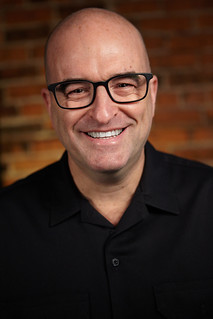 About the Interviewer
About the Interviewer
Greg Bennick (www.gregbennick.com) is a keynote speaker and long time coin collector with a focus on major mint error coins. Have ideas for other interviewees? Contact him anytime on the web or via instagram @minterrors.
To watch the complete video, see:
Kellen Hoard Interviewed for the NNP by Greg Bennick
(https://youtu.be/tBb-Bt4NR8k)
To read the complete transcript, see:
Kellen Hoard Interviewed for the NNP by Greg Bennick (Transcript)
(https://nnp.wustl.edu/library/book/641580)
To read the earlier E-Sylum article, see:
KELLEN HOARD INTERVIEW, PART ONE
(https://www.coinbooks.org/v27/esylum_v27n41a24.html)
CLEMENTINE D'ORLEANS: FEMALE NUMISMATIST
Künker recently released this article on female coin collector Clémentine d'Orléans. Her collection will be sold as part of the estate of Dr. Alexander Eugen Duke of Württemberg, the final part of which will be sold in Künker's upcoming Auction 415 on 28 October 2024. -Garrett
On 3 June 1817, Maria Amalia of Naples and Sicily, wife of Louis Philippe, Duke of Orléans, gave birth to her sixth of what would eventually be ten children: a daughter, elaborately christened Marie Clémentine Léopoldine Caroline Clotilde. At the time of her birth, Louis Philippe was far from a contender for the throne. He was serving as general in the French army and was a loyal supporter of the recently restored Bourbons Louis XVIII and Charles X.
There may have been a slight uneasiness, however, as Louis Philippe's father – an enthusiastic supporter of the Enlightenment – had supported the French Revolution under the name Philippe égalité. Although, like many others, he had died on the guillotine during the Reign of Terror, he had raised his son according to the ideals of a new, enlightened and economically strong bourgeoisie. Maybe this is what gave Louis Philippe his uncanny ability to read the signs of the times. He traveled to England and the United States and had discussions with (for that time) progressive politicians like George Washington and Alexander Hamilton. At the same time, though, he also maintained strong ties to important banking houses such as Rothschild and Laffitte.
Louis Philippe perfectly knew how to handle money, including his own. He used the most modern investment methods to expand the already enormous family fortune. Even before his accession to the throne, Louis Philippe was one of the wealthiest men in France. As early as 1821, his fortune was estimated at around 8 million francs – and it was to increase considerably.
A Modern Upbringing for the Children
Louis Philippe also shared the upbringing ideals of the French bourgeoisie. The fact that family life should be loving and involve plenty of contact between parents and children was a given for him. Clémentine – or Titine, as she was affectionately called by her siblings – experienced an almost normal upbringing. They dined and celebrated as a family; they traveled together to the countryside, where Titine and her siblings gallivanted in parks and swam in ponds.
Naturally, each of the children also received an excellent education. For the girls, this meant a troupe of governesses and tutors who taught them embroidery and dancing, etiquette and conversation, and, of course, the mastery of a musical instrument (the harp, in Clémentine's case) that was inevitably expected of every little girl. The syllabus was rounded off by various languages as well as religious education personally provided by Maman. The father was also involved in educating his children. He had some experience, after all, having taught French to make ends meet during his years of exile. Louis Philippe taught his children history and geography using memorabilia from the family estate. Clémentine completed her education by embarking on the Grand Tour, which was more usual for young men at the time. She journeyed to the mountains of Switzerland and beheld the wonders of Italy.
Whether Clémentine had already begun to take an interest in coins at this time cannot be known for sure. But we do know that she was not the only family member interested in numismatics. Among her close relatives were several prominent collectors. The most well-known of these today is Henri, Duke of Aumale, who assembled such an extensive collection of paintings and art objects that his coin collection tends to be forgotten. Clémentine's eldest son Philipp was also an ambitious numismatist. He published works on oriental numismatics, and his collection was auctioned off by the Leo Hamburger auction house in Frankfurt in 1928.
Although, in the 19th century, it was widely considered good form for an educated man to collect at least a few coins, this was not really the case for women. And the reason for this probably was not even a lack of interest: most women just did not have the necessary financial means to purchase coins. But this was not the case for Clémentine. She had one of the largest fortunes in Europe.
To read the complete article, see:
Clémentine d'Orléans: Extraordinary Woman and Coin Collector
(https://www.kuenker.de/en/information/presseinformationen/aktuelle-mitteilungen/590)
CULTURAL CURRENCY MONEY ART EXHIBIT
John Mellman passed along information about an upcoming exhibit of money art at the Carlsbad Museum in New Mexico. Thanks! "Cultural Currency: Contemporary Art from the Riemer Collection" is a traveling exhibit appearing at Carlsbad November 1, 2024 through January 24, 2025. Their site has little information, but I was able to find more at the websites of museums where the exhibit has toured before. -Editor
Cultural Currency explores the innovative ways artists use money as a medium to expand its worth beyond a given denomination. Each of the artists featured investigates preconceived definitions of monetary value, meticulously repurposing bills and coins into exquisite, precise artworks. Universally relevant, humorous and, at times, critical, Cultural Currency asks viewers to consider how the definition of currency can be reshaped into a multifaceted object steeped in meaning and intrigue. The collection is the passion of Louise Rothman-Riemer and Davis Riemer, investment advisers from Oakland, California, who began collecting money-themed art in 1995 to encourage new attitudes toward money's intrinsic value.
Some 38 artists are represented, including J. S. G. Boggs and Mark Wagner. Here are some of the works. I like these. -Editor
For more information, see:
https://www.bedfordgallery.org/exhibitions/traveling-exhibitions/cultural-currency
https://www.lywam.org/exhibition/cultural-currency-contemporary-art-from-the-riemer-collection/
https://www.carlsbadmuseum.org/upcoming-exhibitions
ATLAS NUMISMATICS SELECTIONS: OCTOBER 20, 2024
Atlas Numismatics has updated their website with 376 new coins, medals, and tokens at fixed prices. Selections include the following items. Some great pieces! -Editor
1080272 | GREEK. PTOLEMAIC KINGS OF EGYPT. Ptolemy VI. Struck circa 180-145 BC. AR Tetradrachm. NGC Ch. AU? (Choice About Uncirculated ?) Strike 5/5 Surface 5/5. Alexandreia Mint. 14.03gm. Diademed head of Ptolemy I right, wearing aegis around neck / Eagle standing left on thunderbolt; no control marks. Svor-1231 & 1489; SNG Cop-244-5 & 262-8.
Beautiful deep cabinet patina; given the star designation by NGC for exceptional eye appeal.
$6,950
To read the complete item description, see:
https://atlasnumismatics.com/1080272/
1080295 | FRANCE. Napoleon I. (Emperor, 1804-1814, 1815). 1811 AV Medal of 9 Ducats Weight. PCGS SP63. By Bertrand Andrieu. Paris mint. Edge: Plain. 32mm. 31.80gm. Conjoined and laureate bust of Napoleon I and Marie-Louise of Austria, right, signed below truncation / NAPOLEON FRANCOISE JOSEPH - CHARLES ROI DE ROME// XX MARS MDCCCX. Child's bust, left, signed on truncation, date of birth below in Roman numerals. Bramsen 1100; cf. Julius 2432 (in silver).
Commemorating the birth of the King of Rome, on March 20, 1811. Superb reflective surfaces; minor rim abrasion (not visible in holder).
$27,950
To read the complete item description, see:
https://atlasnumismatics.com/1080295/
1080249 | GERMAN STATES. Brunswick-Wolfenbuttel. August Wilhelm. 1728 EPH AR Thaler. NGC MS64. Zellerfeld. PARTA TVERI. Wildman, tree in left hand, legend divided above, mintmaster's initials and symbol at lower left / D.G. AVGVSTVS. WILHELMVS. DVX. BR. & LVN. Spanish shield of 11-fold arms, 5 ornate helmets above, date at end of legend. KM 739; Dav.-2126.
Beautifully toned.
$4,950
To read the complete item description, see:
https://atlasnumismatics.com/1080249/
1080229 | GREAT BRITAIN. England.
James II. (King, 1685-1688). 1688 AV Five
Guineas. NGC MS62. Edge: +•+• DECVS • ET • TVTAMEN • ANNO • REGNI •
QVARTO •. Laureate bust of James II left / Crowned cruciform shields, sceptres in
angles. KM 460.1; SCBC-3397A; Schneider II, 453/-; ESG-315 (Bull); MCE 119.
$159,500
To read the complete item description, see:
https://atlasnumismatics.com/1080229/
1080109 | GREAT BRITAIN.
Victoria. (Queen, 1837-1901). 1893-LVI AR Crown.
PCGS PR66 Cameo. Edge: DECVS ET TVTAMEN ANNO REGNI. VICTORIA · DEI
· GRA · BRITT · REGINA · FID · DEF · IND · IMP. Mature draped bust left / St.
George slaying dragon right. KM 783; SCBC-3937; ESC-303; Dav.-108.
$28,950
To read the complete item description, see:
https://atlasnumismatics.com/1080109/
1080565 | NETHERLANDS. Utrecht. 1786 AR 1/2 Ducaton, 1/2 Silver Rider. PCGS MS67. Edge: Reeded. MO : NO : ARG : CON : FOE : BELG : PRO : TRAI ·. Armored knight on horse above crowned shield / CONCORDIA RES PARVÆ ... Crowned arms of Utrecht, with supporters, date below. KM 115.1.
Superb and exceptional; the finest example of the type we have encountered.
$19,500
To read the complete item description, see:
https://atlasnumismatics.com/1080565/
Updates to their online inventory are issued monthly. For more information and to sign up for the firm's monthly newsletter, visit: atlasnumismatics.com.
NUMISMAGRAM MEDAL SELECTIONS: OCTOBER 20, 2024
Jeremy Bostwick with Numismagram forwarded these three medals from his upload of new Halloween-themed medallic art to his site. For all of the new items, please visit https://www.numismagram.com/inventory, and be on the lookout for more being added this week. Some great medals! -Editor
102943 | GREAT BRITAIN. Warwickshire. Birmingham. Copper Penny Token. Issued 1791 (34mm, 16.96 g, 12h). OUR FOOD IS SEDITION, winged and serpentine Monster of Sedition carrying flag with phrygian cap; four imps flying around (three of which are suckling from her numerous teats) // NOURISHED TO TORMENT, snake basking in long grass; the sun's rays above; in two lines in exergue, 14 JULY / 1791. Edge: A few scattered marks, otherwise plain. D&H 34; BHM 360. Extremely Fine. Warm brown surfaces; minor edge flaw noted for completeness. $395.
Alluding to the Birmingham riots of 1791 as well as the second anniversary of the French Revolution, this type remains exceptionally popular on account of its haunting imagery.
To read the complete item description, see:
102943 | GREAT BRITAIN. Warwickshire. Birmingham. Copper Penny Token.
(https://www.numismagram.com/product-page/102943)
102694 | GERMANY. Franz Joseph Gall silver Medal. Issued 1805. Commemorating the founder of phrenology (40mm, 18.14 g, 12h). By Abraham Abramson in Berlin. IOSEPHO GALL ORGAN IN CEREBRO SCRVTATORI, bust right in frock coat // DISTRIBVIT PARTES ANIMAE SEDESQVE, skull facing right, with back turned toward the viewer; in two lines in exergue, AVDITOR BEROLINENS / MDCCCV. Edge: Plain. Brettauer 375; Hoffmann 208. PCGS MS-63. Deeply toned, with some enchanting brilliance in the fields. A very rare type, especially so enticing and attractive, and the only example observed in the PCGS census. $965.
Gall was a noted physiologist and neuroanatomist, and most well-known as the father of phrenology. From an early age, Gall was interested in the classification and differences in human abilities and tendencies. He began noting that these aptitudes could be linked to various areas of the brain, each responsible for different characteristics. The random bumps on one's skull were, he believed, due to pressure exerted by the brain from beneath. Wildly popular and accepted in his time, phrenology is now viewed entirely as a pseudoscience that has been repeatedly disproven. Nevertheless, the contributions which he made to modern neuroscience cannot be overlooked.
To read the complete item description, see:
102694 | GERMANY. Franz Joseph Gall silver Medal.
(https://www.numismagram.com/product-page/102694)
102562 | GERMANY & GREAT BRITAIN. Sinking of the HMS Courageous cast iron Medal. Dated 1939. "Totentanz (Dance of Death) Redux" type (70mm, 92.43 g, 12h). By Guido Goetz. DIE HIOBSBOTSCHAFT AN CHURCHILL (bad news for Churchill), Death, wearing cape, advancing right, holding scroll inscribed with a swastika and TORPED. / VON / DEUTSCH. / "U" / BOOT / 18 SEPT 1939 in six lines // RULE BRITANNIA!, the British Isles (as Neptune) standing left in the ocean, holding trident, hoisting the HMS Courageous over his shoulder, and wearing man purse decorated with Union Jack. Edge: Plain. Engstrom 4. PCGS MS-63. Charcoal-gray surfaces and charming relief. A haunting and scarce type. $965.
Carrying on the tradition of his father, Guido Goetz also had a career as a medalist, issuing some satirical pieces in the vein of the elder Goetz, Karl. Just as World War I and its aftermath were important to the work of the father, so too was that of World War II to the son, with a number of satirical medals designed with this backdrop. Drawing upon the skeletal approach of Walther Eberbach's Totentanz series, some of Guido's issues portray Death as a skeleton taking sadistic glee in the downfall of his enemies.
The HMS Courageous was built for the Royal Navy during World War I, serving as the class leader of the Courageous-class cruisers. Following the war, she was rebuilt as an aircraft carrier in the 1920's, being used in this role briefly during World War II. In the opening weeks of the war, not long after the torpedoing of the SS Athenia, the Courageous was also torpedoed and sunk, this time by U-29, losing 519 of her crew.
To read the complete item description, see:
102562 | GERMANY & GREAT BRITAIN. Sinking of the Courageous cast iron Medal.
(https://www.numismagram.com/product-page/102562)
HERITAGE AUCTION: INDIA PAST AND PRESENT
Heritage Auctions will be hosting their India: Past and Present Spotlight Auction on October 28. Some selections from their October 15, 2024 Heritage Coin News email are discussed below. -Garrett
Our October 28 Spotlight India: Past and Present Auction highlights the rich and diverse numismatic history of the Indian subcontinent. This impressive auction features an array of Hunnic and Kushano-Sasanian issues, alongside fine selections from Bactrian and Indo-Scythian eras. Mughal enthusiasts will appreciate a handful of truly choice gold issues, complemented by stunning silver and gold pieces from Hyderabad. Rounding out the Showcase is a large offering of mint state examples from British India, sure to captivate collectors of Indian coinage through the ages.
A remarkable chapter in the annals of Central Asian history is the era of the Kushano-Sasanian Kingdom from the mid-third century to the mid-fifth century AD, flourishing as a historical intersection of the Kushan and the Sasanian Empires. While the Kushans were a major power in South and Central Asia, the Sasanians hailed from Persia, creating an intriguing blend of cultures and traditions within the kingdom. Hormizd I is predominantly known for his significant role in fostering cultural syncretism during his reign. As mentioned above, this auction has a nice offering of Kushano-Sasanian issues, led by an AU gold dinar of Hormizd I Kushanshah (Ohrmazd) struck ca. AD 285-300.
The Indian subcontinent has produced a wide variety of coinage through the years, including:
BACTRIAN KINGDOM. Eucratides I the Great (ca. 170-145 BC). AR tetradrachm (36mm, 16.82 gm, 12h). NGC AU 5/5 - 3/5. Attic standard. Uncertain mint in the Paropamisadai or Gandhara. Diademed, draped, and cuirassed bust of Eucratides I right, seen from side, wearing crested Boeotian helmet adorned with bull horn and ear; bead-and-reel border / ??S???OS ??G???Y / ??????????, the Dioscuri on horses prancing right, both with couched spear in right hand, palm in left over shoulder; ??? monogram in lower right field. Bopearachchi 6E. HGC 12, 131.
To read the complete item description, see:
BACTRIAN KINGDOM. Eucratides I the Great (ca. 170-145 BC). AR tetradrachm (36mm, 16.82 gm, 12h). NGC AU 5/5 - 3/5.
(https://coins.ha.com/itm/ancients/greek/ancients-bactrian-kingdom-eucratides-i-the-great-ca-170-145-bc-ar-tetradrachm-36mm-1682-gm-12h-ngc-au-5-5/a/61424-21002.s)
BACTRIAN KINGDOM. Eucratides II (ca. 145-140 BC). AR tetradrachm (34mm, 16.81 gm, 11h). NGC Choice AU 4/5 - 3/5, die shift. Diademed and draped bust of Eucratides II right, seen from front; bead-and-reel border / ??S???OS / ??????????, Apollo standing facing, head left, examining arrow in right hand, resting left hand on grounded bow; HA monogram in inner left field. Bopearachchi Série 1I (unlisted monogram for type). HGC 12, 161.
To read the complete item description, see:
BACTRIAN KINGDOM. Eucratides II (ca. 145-140 BC). AR tetradrachm (34mm, 16.81 gm, 11h). NGC Choice AU 4/5 - 3/5, die shift.
(https://coins.ha.com/itm/ancients/greek/ancients-bactrian-kingdom-eucratides-ii-ca-145-140-bc-ar-tetradrachm-34mm-1681-gm-11h-ngc-choice-au-4-5-/a/61424-21003.s)
INDIA. Post-Gupta (Samatata). Ratas. Sri Jivadharanarata (ca. AD 650-680). AV dinar (20mm, 5.52 gm, 10h). Choice XF. Stylized archer standing facing, head left, bow in left hand, arrow in right; Trisula standard behind surmounted by open crescent at top at left, Sri (Brahmi) in upper left field, JiVa in lower right field, dotted border / Stylized goddess standing right; pseudo-characters on right, dotted border. Cf. MACW 4924 (Third Gupta Dynasty of West Bengal, ca. AD 550-700). TOTGE, pg. 402.
To read the complete item description, see:
INDIA. Post-Gupta (Samatata). Ratas. Sri Jivadharanarata (ca. AD 650-680). AV dinar (20mm, 5.52 gm, 10h). Choice XF.
(https://coins.ha.com/itm/ancients/ancient-india/ancients-india-post-gupta-samatata-ratas-sri-jivadharanarata-ca-ad-650-680-av-dinar-20mm-552-gm-10h-ch/a/61424-21030.s)
INDIA. Regional Coinage. Kashmir. Shri Sahi (?) (ca. AD 380-430). AV dinar (25mm, 7.87 gm, 12h). Choice MS. Imitating Kidara issues. King standing facing, standard in left hand, sacrificing over altar to left, degraded style; Kidara (Brahmi) beneath left arm, Kapan in left field, Kushana in right field / Ardoxsho, nimbate, seated facing, cornucopia cradled in left arm, degraded style. Donum Burns 1953-1956. MACW 3695-3702.
To read the complete item description, see:
INDIA. Regional Coinage. Kashmir. Shri Sahi (?) (ca. AD 380-430). AV dinar (25mm, 7.87 gm, 12h). Choice MS.
(https://coins.ha.com/itm/ancients/ancient-india/ancients-india-regional-coinage-kashmir-shri-sahi-ca-ad-380-430-av-dinar-25mm-787-gm-12h-choice-ms/a/61424-21060.s)
Awadh. Ghazi al-Din Haidar gold Mohur AH 1234 Year 26 (1818/1819) MS62 NGC, Muhammadabad Banaras mint, KM150. A stunning selection and one of the more instantly recognizable types of Awadh origin, positively beaming with golden resplendence and originality.
From the L. William Libbert Collection
To read the complete item description, see:
Awadh. Ghazi al-Din Haidar gold Mohur AH 1234 Year 26 (1818/1819) MS62 NGC,
(https://coins.ha.com/itm/india/awadh/india-awadh-ghazi-al-din-haidar-gold-mohur-ah-1234-year-26-1818-1819-ms62-ngc-/a/61424-21090.s)
Bahawalpur. Sir Sadiq Muhammad Khan V silver Medallic Nazarana Rupee AH 1343 (1925) MS64 PCGS, Bahawalpur mint, KMX-M10. A difficult type, especially in comparable preservations, with only the most trivial of marks to preclude this survivor from Gem assignment.
To read the complete item description, see:
Bahawalpur. Sir Sadiq Muhammad Khan V silver Medallic Nazarana Rupee AH 1343 (1925) MS64 PCGS,
(https://coins.ha.com/itm/india/bahawalpur/india-bahawalpur-sir-sadiq-muhammad-khan-v-silver-medallic-nazarana-rupee-ah-1343-1925-ms64-pcgs-/a/61424-21094.s)
Hyderabad. Mir Mahbub Ali Khan II gold Ashrafi AH 1325 Year 41 (1907/1908) MS63 NGC, Hyderabad (Farkhanda Bunyad) mint, KM-Y44.1. A praiseworthy representative of a series we find relatively few examples of from the early 20th century, here preserved at a commendable Choice assignment.
To read the complete item description, see:
Hyderabad. Mir Mahbub Ali Khan II gold Ashrafi AH 1325 Year 41 (1907/1908) MS63 NGC,
(https://coins.ha.com/itm/india/hyderabad/india-hyderabad-mir-mahbub-ali-khan-ii-gold-ashrafi-ah-1325-year-41-1907-1908-ms63-ngc-/a/61424-21110.s)
Patiala. Bhupindar Singh gold 2/3 Mohur VS (19)58 (1900/1901) MS66 NGC, KM-Y36, Zeno-83470. 7.45gm. Citing the Durrani Ahmad Shah. A scarcer type especially in this grade, which presently ranks as tied with one other for the finest. A stunning rendition with boisterous luster.
To read the complete item description, see:
Patiala. Bhupindar Singh gold 2/3 Mohur VS (19)58 (1900/1901) MS66 NGC,
(https://coins.ha.com/itm/india/patiala/india-patiala-bhupindar-singh-gold-2-3-mohur-vs-19-58-1900-1901-ms66-ngc-/a/61424-21133.s)
THE SISI AND FRANZ NIGHTMARE WEDDING
As part of the phaleristic auction 415 on 28 October 2024, Künker will be auctioning the set of gold medals that Emperor Franz Joseph presented to his father-in-law, Duke Maximilian Joseph in Bavaria. It is the numismatic souvenir of a wedding that turned out to be a nightmare for his daughter – young Elisabeth, who is better known as Sissi or Sisi today. -Garrett
Sisi and Franz: Commemorating the Dream Wedding that Was Actually a Nightmare
by Ursula Kampmann on behalf of Künker

Official commemorative set with two gold medals with the weight of 35 ducats each from the estate of Max Joseph in Bavaria, the father of Empress Elisabeth of Austria-Hungary. Estimate: 40,000 euros. From Künker auction 415 (28 October 2024), No. 361.
On Saturday, 22 April 1854, at 4 p.m. on the dot, the paddle steamer Franz Joseph docked at Nussdorf near Vienna to the sound of celebratory gunfire and shouts of "vivat". On board was a frightened 16-year-old, struggling to keep her composure. Dressed in pink silk, she stood and waved with her lace handkerchief at the cheering crowd that was eager to catch a glimpse of their future empress. Tens of thousands of people crowded along the riverbanks and streets, peering out of windows and from stands, just to cast a glance at the future ruler of their country. The latter let all the speeches and greetings, all the poems and tributes wash over her without complaint before the procession of carriages finally formed to take the entire court to Schönbrunn.
Sisi's Loving Father
Let us take this opportunity to look at the family who was marrying off their daughter in Vienna. Duke Max Joseph in Bavaria, the bride's father, sat in the first open two-horse carriage with the bridegroom. Many people still think of him as he was portrayed by Gustav Knuth in Hubert Marischka's legendary "Sissi" movies – as a loving father and the archetype of cozy Bavarian "Gemütlichkeit".
In fact, Duke Max Joseph in Bavaria was anything but "gemütlich", although he liked to play the zither. He came from the younger branch of the Wittelsbach family, and had an immense income, which he spent on his pleasures. It was not necessary for him to work in such circumstances. He had been forced to marry Ludovika, and he made sure she knew it. He fathered children with her at regular intervals and otherwise did as he pleased. He maintained a small stage and a circus ring in his residence, where he himself occasionally appeared as a clown. Max Joseph traveled a great deal and when he was in Munich, he usually stayed with his non-aristocratic second family. He was much closer to his three illegitimate children than to Elisabeth and her siblings.

The imperial family. Front row from left to right: Elisabeth with her children Rudolf and Gisela, Sophie and her husband Archduke Franz Karl of Austria. Second row from left to right: Maximilian (of Mexico), Emperor Franz Joseph, Charlotte, Maximilian's wife, the Archdukes Karl Ludwig and Ludwig Viktor. Photo taken by Ludwig Angerer c. 1860.
The Evil Mother-in-Law
The bride waved from the following carriage. Proudly seated beside her was Empress Mother Sophie, who is stylized in the Marischka movies as a truly evil mother-in-law. In fact, Sophie is more like the secret heroine of the story, and today we would rather speak of her as a strong woman.
Sophie Friederike was Ludovika's sister and therefore a real aunt of Elisabeth in Bavaria. In her day she was considered one of the most beautiful women in Germany: Ludwig I had her immortalized for his "gallery of beauties". At the age of 19, Sophie married Franz Karl of Austria, the emperor's younger son. Not of love, of course. Her big moment came in the revolutionary year of 1848, when Emperor Ferdinand was forced to abdicate. Sophie ensured that her son, not her husband, would ascend the throne, and his youthfulness won the hearts of the people.
Sophie had brought up her son in a dutiful and arch-conservative manner. While his bride was completely overwhelmed by the festivities of the wedding week, the 24-year-old managed to take care of the daily affairs of the state at the same time. Neither he nor his mother would have been able to understand what following the rules of court ceremonial demanded of Elisabeth. She may have had an excellent upbringing, but discipline and affability had not been part of her curriculum at Possenhofen Castle.
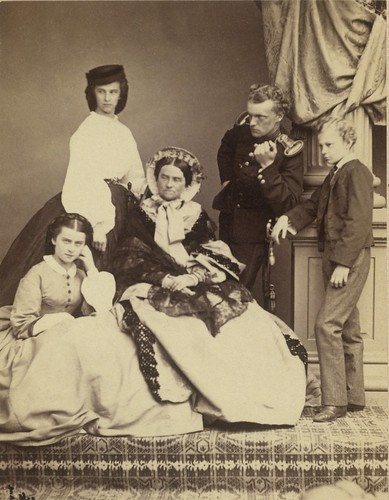
Ludovica surrounded by some of her children, from left to right: Sophie, Mathilde, Carl Theodor and Maximilian. Photo taken by Hermann Holz c. 1860.
Sisi's Dutiful Mama
The bride's mother, Ludovica, sat next to Archduke Franz Karl in the third carriage. One might wonder whether she smiled on this rare occasion. She never did. And that should not be a surprise. She had not been happy in life. She too had loved and been loved. She would have happily accepted the hand of the King of Portugal, but her father would not have it.
So she was left with an absent husband and a growing number of children. What she lacked in tenderness, she made up for with a passionate love for her dogs.
She could not bear to stay in her husband's Munich palace. As soon as spring arrived, she and her children moved to Possenhofen and stayed there as long as the weather permitted. This meant that Sisi and her siblings were little accustomed to the city and even less to court ceremonies. It did not help that Ludovika hired the best teachers for her children. Her proficiency in mathematics, geography and history did not help her daughter to move confidently in Vienna's highest society. Disaster was inevitable.
Arrival in Vienna and an Accident
It is hard to imagine how tired little Sisi must have been when, after the gala dinner, she fell into bed well after midnight on the evening of her arrival. She was not allowed to sleep in the next day. After all, the move to Vienna was on the agenda. First she had to get dressed – a rather complex procedure – to then make the short journey from Schönbrunn to the Theresianum. There she was dressed up even more elaborately. Elisabeth now wore a scratchy rosé gown with silver touches, a crinoline and a long train embroidered with garlands of roses. A high tiara balanced on her head, threatening to slip off with the slightest movement. We know that the exhausted girl in the glass coach cried from the moment she got in until the moment she got out. The people cheering in the streets were treated to the spectacle of a hysterical, red-eyed princess, crying her eyes out and unable to pull herself together. As she stepped out of the carriage, her tiara got caught on something and she would have fallen if a servant had not caught her. All this in front of the entire court that had gathered to welcome her to the residence. This certainly must have caused even more tears...

Reverse of the wedding medal, whose dies by Konrad Lange had been produced on behalf of the Vienna Principal Mint. They depict the couple while receiving the blessing.
The Wedding Ceremony
Elisabeth was allowed to sleep in the next day. At least we hope so. It would be understandable if she did not manage to get a wink of sleep in the night before the wedding. The church wedding was scheduled for 6.30 p.m. It took place in the Augustinian Church, which was lit by 15,000 candles. The ceremony was performed by the Vienna Archbishop Rauscher, who can be seen between the couple on the medal created by Konrad Lange for the wedding. He was assisted by 70(!) bishops and prelates. Archbishop Rauscher – nicknamed "Plauscher", which translates to "the chatty one", for his loquaciousness – gave everyone a masterclass in endurance with his sermon.
But the wedding itself was only the beginning of the festivities. The newlyweds now had to endure the congratulations of the entire elite of the Habsburg Monarchy. Everyone who was anyone had traveled to this celebration and crowded into the halls of the Hofburg. At some point the overwhelmed Elisabeth could no longer stand it. She rushed out of the hall, wept profusely in an adjoining room, while the perplexed royal household did not know how to handle the situation. Eventually they managed to get Elisabeth back, but then the next problem arose: Elisabeth was shy and had never seen so many people in one place before. Of course she could not say a single word. But given her high rank, nobody else was allowed to start a conversation with her – unless she spoke fist. So everyone stood in awkward silence until Princess Esterhazy, who had been appointed as Elisabeth's chaperone, took heart and, breaking the rules, asked a few ladies to direct some words at the Empress.
But of course, this reception was not the end of the festivities. Next were festive illuminations, and the young couple's carriage was driven through the streets of Vienna for hours on end so they could admire them. Only then did the wedding feast begin, with endless speeches and shouts of "vivat". There was no energy left for the wedding night. We know this because the next morning both mothers interrupted the couple's breakfast to find out whether Elisabeth had become a woman. (She had not. Sources say that she did not become one until the third night of her marriage.)

Official commemorative set with two gold medals with the weight of 35 ducats each from the estate of Max Joseph in Bavaria, the father of Empress Elisabeth of Austria-Hungary. Estimate: 40,000 euros. From Künker auction 415 (28 October 2024), No. 361.
A Souvenir for the Participants
Our description of the wedding celebration ends here, but they were far from over for Elisabeth. She had to endure a play and a court ball, a folk festival and the town ball. It was a kind gesture on the part of her young husband that, on the fourth day, he canceled the exhausting receptions in order to take his wife for a ride through the Prater – this time in an inconspicuous carriage driven by the Emperor himself, which could be covered by a canopy so that the occupants could not be seen.
He must have realized that otherwise Elisabeth would not have been able to go through the festivities without a nervous breakdown. After all, they had to maintain their imperial image. It was a disaster for the Emperor that tens of thousands of people had seen how unhappy his bride was before the wedding. Her tears must not be seen in the official media. In those pictures and reports, she had to shine – as she did on the official wedding medal that had been commissioned from the Vienna Principal Mint long before the actual event.
The court required such medals for all major festivities, to be distributed as souvenirs to the participants. Careful consideration was given to the position and rank of the recipient. The bride's father, Max Joseph in Bavaria, naturally received a first-class commemorative set. It contained two heavy gold medals in the weight of 35 ducats each, which is 122.2 or 122.3 g. They were presented in a small box made of red maroquin leather, lavishly decorated with brass applications.
In terms of uniqueness and exclusivity, such a set cannot be compared with the unboxed medals struck with the same dies, which are more frequently found at auction. They are available in gold, silver and bronze, although the Vienna Principal Mint only produced bronze medals for sale. Silver and gold medals were only used as gifts, but if the administration had miscalculated their orders and there were too many medals, they could be given to interested citizens who were prepared to pay a high premium. They were not, of course, delivered as a magnificent commemorative set in an elaborately designed box. Such objects were only created for high guests.
The Künker auction house in Osnabrück is proud to offer this memorabilium in auction 415.
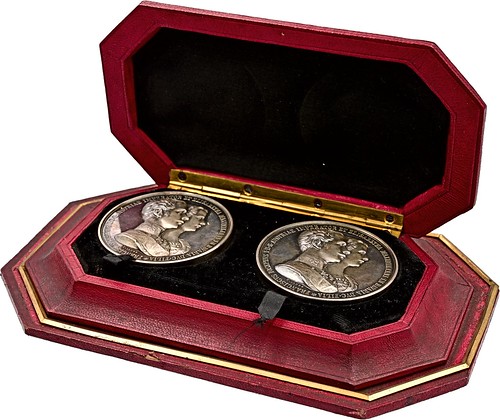
Official commemorative set with two silver medals from the estate of Carl Theodor in Bavaria, the brother of Empress Elisabeth of Austria-Hungary. Estimate: 4,000 euros. From Künker auction 415 (28 October 2024), No. 362.
Sisi's Favorite Brother "Gackerl" Carl Theodor in Bavaria
Auction 415 includes not only the official commemorative set given to the bride's father, Max Joseph in Bavaria, but also a second set in silver that belonged to Sisi's favorite brother. Carl Theodor was a year and a half younger than Elisabeth and was nicknamed "Gackerl" (little rooster) by her. Along with all her siblings, he accompanied her through the week's festivities, but had to rejoin the Royal Bavarian 3rd Chevau-légers immediately afterwards. The 14-year-old had been serving as sub-lieutenant in this regiment since the 12 October 1853. Sisi was so distraught by his departure that within a week she begged her husband to make Gackerl come to Vienna for a few days. Franz Joseph agreed, making his young wife very happy. The close relationship between the two sibling was to last for many years and was passed on to their children.
After the death of his father Max Joseph on 15 November 1888, Carl Theodor became head of the House of Wittelsbach in Bavaria. In this capacity, he inherited the gold commemorative set that his father Max Joseph had received from Emperor Franz Joseph, together with many other Wittelsbach memorabilia. Ulrich Künker comments: "We are very honored to be auctioning a selection of important items from the estate of Carl Theodor and his remarkable wife Marie José of Braganza. It was both an honor and an imperative for us to document the objects in this estate as well as possible and to place them in their historical context."
The catalog of auction 415 compiled by Michael Autengruber can be ordered from Künker, Nobbenburger Straße 4a, 49076 Osnabrück; phone: +49 541 / 962020; fax: +49 541 / 9620222; or via e-mail: service@kuenker.de. It is also available online at www.kuenker.de/en. There you will also find additional information about the remarkable life of Carl Theodor in Bavaria and his wife Marie José.
KUENKER AUCTION 416
Künker's auction 416 presents exquisite coins from the ancient world. Highlights are the Druckrey Collection of Greek coins, a Brutus aureus, as well as the collection of Clémentine d'Orléans, daughter of Citizen King Louis Philippe and mother of Tsar Ferdinand I of Bulgaria. -Garrett
Künker, Osnabrück
Auction 416
Osnabrück, 29-30 October 2024
Ancient Greek Coins from the Druckrey Collection at Künker
On 29 and 30 October 2024, the Künker auction house will hold auction 416. It contains 1038 lots with select Greek, Celtic, Roman and Byzantine coins as well as issues from the Migration Period and the Islamic world. We present a few highlights.
The Dr. Eike Druckrey Collection
"The Aesthetics and the World of Thought of the Early Greeks" – this is the title of and the idea behind Dr. Eike Druckrey's collection of 305 exquisite Greek coins. He was not interested in accumulating as large a collection as possible, but rather in selecting the most beautiful works of art from the Greek Archaic and Classical periods that related to Hellenic ideas and concepts. This collection will open auction 416 on 29 October. Connoisseurs will be delighted to see all their favorites: Poseidonia, Kaulonia, Kamarina, Naxos, Syracuse, Abdera, Athens, Corinth... In short – anything that true lovers of Greek coinage dream of can be found in this collection. The beauty of these issues speaks for themselves. And they are a testament to Dr. Eike Druckrey's keen eye for detail in selecting these pieces.
No. 1015: Poseidonia / Lucania. Stater, 530-500. From the Charles Gillet Collection, Bank Leu auction 77 (2000), 51. Very fine +. Estimate: 7,500 euros
No. 1044: Kamarina / Sicily. Didrachm, 415-405. From Sotheby's auction L09447 (1999), 10. Very fine +. Estimate: 7,500 euros
No. 1070: Syracuse / Sicily. 100 litrae, 405-400. Obv. signed by Euainetos. From the Virgil Brand Collection, purchased in 1915 from Jacob Hirsch. Extremely fine. Estimate: 10,000 euros
No. 1108: Abdera / Thrace. Stater, 362 BC. From CGB auction 47 (2011), No. 46. About extremely fine. Estimate: 10,000 euros
No. 1222: Magnesia / Ionia. Themistocles, + 459 BC. Trihemiobol, 464-459. From Roma Numismatics XVII (2019), No. 443. Very rare. Very fine +. Estimate: 1,500 euros
No. 1295: Ptolemy II, 285-246 / Egypt. AE obol, 264-263, unknown Sicilian mint. From Nomos auction 2 (2010), No. 150. Very rare. Extremely fine +. Estimate: 3,000 euros
A Celtic Rarity of the Highest Historical Importance
After the Druckrey Collection, ancient rarities from various possessions will be presented. You can look forward to a beautiful series of Celtic gold coins, including a hemistater of the Caletes, who gave their name to Pays de Caux in Normandy, and an impressive gold stater of the Eburones of the highest historical importance. After all, the motif of this coin is associated with an episode of the Gallic Wars. Modern historians believe this depiction to be a means of propaganda for a Celtic uprising against the Roman troops. In fact, the Eburones resisted Roman conquest. Led by their king Ambiorix, they attacked a Roman winter camp in mid-November 54 BC. The 15 cohorts stationed there left in a hurry and were completely annihilated. Around 10,000 legionaries are said to have died, equating to about a fifth of the troops stationed in Gaul. Caesar took his revenge in 53 and 51 BC. He massacred all the Eburones he could find, burned their farms and drove off their cattle. There is archaeological evidence of this. After Caesar's punitive campaign, the Eburones no longer existed.
No. 1503: Celts. Eburones. Stater, middle of the 1th century BC. Extremely rare. Possibly the finest specimen of this type. Extremely fine. Estimate: 12,500 euros
Greek Coins from Various Possessions
Connoisseurs will also find numerous rarities in the section of Greek coins from various possessions, including an extremely rare 100-litrae piece from Syracuse, signed by Kimon, with a provenance dating back to 1917. Of exceptional beauty is a posthumous gold stater of the Philip II type, whose Apollo head reminds of the portrait of Alexander the Great. A wonderful drachm of Pherae is from the BCD Collection. Thanks to its immaculate condition, the elaborate depiction really comes into its own. And the same holds true regarding an archaic didrachm from Erythrae.
No. 1561: Syracuse / Sicily. 100 litrae, 405-400. Obv. signed by Kimon. From the collection of a North German friend of ancient coins. From the R. Jameson Collection. Very rare. Extremely fine. Estimate: 50,000 euros
No. 1598: Philip II of Macedon. Gold stater, posthumous, 323-317, Colophon. Extremely fine +. Estimate: 25,000 euros
No. 1623: Pherae / Thessaly. Drachm, 460-440. From Hess auction 253 (1983), No. 165 and the BCD Collection. Very rare. Extremely fine. Estimate: 12,500 euros
No. 1651: Erythrae / Ionia. Didrachm, before 480 BC. Rare. Extremely fine. Estimate: 15,000 euros
No. 1704: Judaea. Shekel, year 3 (= 68/69), Jerusalem. From the Samel Collection, Künker auction 334 (2020), No. 2264. Extremely fine. Estimate: 10,000 euros
No. 1706: Judaea. Tetradrachm, 133/4. From the Samel Collection, Künker auction 334 (2020), No. 2404. Extremely fine. Estimate: 10,000 euros
Aurei of Brutus and Pompeius
Künker is pleased to be able to offer a Brutus aureus, which was purchased from Spink & Son in London on 12 September 1969. The coin dates from 42 BC and is one of the issues used to finance the military campaign of Caesar's assassins. The gold came from contributions of communities in Asia Minor. This aureus was probably struck before the meeting of Brutus and Cassius in Smyrna in early 42 BC, when they discussed how to proceed. The very attractive specimen of about extremely fine quality is estimated at 100,000 euros.
75,000 euros is the estimate of an aureus struck shortly afterwards, showing the portrait of Sextus Pompeius on the obverse, and the heads of his father and brother on the reverse. The coin was minted in 37/6 BC to finance the construction of the fleet.
No. 1809: M. Iunius Brutus. Aureus, 42 BC, mint in Asia Minor (Smyrna?). Purchased on 12 September 1969 at Spink & Son, London. Very rare. About extremely fine. Estimate: 100,000 euros
No. 1822: Sextus Pompeius. Aureus, 37/6 BC, Sicilian mint. Very rare. Very fine. Estimate: 75,000 euros
Roman and Byzantine Rarities
Of course, these two aurei are not the only Roman rarities in this auction sale. Künker's auction 416 features everything a collector's heart desires: rare aurei, fine bronze coins, denarii with excellent portraits, and some interesting provincial issues – there is truly something for everyone.
No. 1834: Marcus Antonius and Cleopatra. Tetradrachm, ca. 36 BC, unknown mint. Very rare. Very fine +. Estimate: 40,000 euros
No. 1970: Aelius. Aureus, 137. From MMAG auction 17 (1957), 462. Rare. Extremely fine / About extremely fine. Estimate: 40,000 euros
No. 2036: Diadumenianus. Quinarius, 217-218. From Triton XX (2017), No. 805. Very fine +. Estimate: 25,000 euros
No. 2077: Uranius Antoninus, 253-254. Tetradrachm, Emesa. From Leu auction 10 (1974), No. 349. Very rare. About extremely fine / Extremely fine. Estimate: 7,500 euros
No. 2078: Postumus, 260-268. Aureus, 258/60, Cologne. From Jacob Hirsch auction XIV (1905), No. 1407. Very rare. Extremely fine. Estimate: 25,000 euros
No. 2106: Constantine I (306-337). Solidus, 313-315, Trier. From Hess-Leu auction 49 (1971), No. 456. Extremely fine. Estimate: 35,000 euros
No. 2108: Crispus. Solidus, 319/20, Trier. From Leo Biaggi de Blasys auction, No. 2058. Very rare. Traces of reworking at the edge. About extremely fine. Estimate: 50,000 euros
No. 2193: Artavasdus, 742-744 with Nicephorus. Solidus. Extremely rare. Very fine. Estimate: 20,000 euros
No. 2200: Alexander, 912-193. Solidus. Very rare. Very fine. Estimate: 20,000 euros
The Clémentine d'Orléans Collection
 The coin collection of Clémentine d'Orléans was entrusted to Künker for auction as part of the estate of Dr. Alexander Eugen Duke of Württemberg, the rest of which will be sold in auction 415. This is a typical collection of the 19th century, with its collector attaching more importance to the historical significance of a coin than to its condition. As a result, this multiple lot of 306 coins contains pieces of many different qualities.
The coin collection of Clémentine d'Orléans was entrusted to Künker for auction as part of the estate of Dr. Alexander Eugen Duke of Württemberg, the rest of which will be sold in auction 415. This is a typical collection of the 19th century, with its collector attaching more importance to the historical significance of a coin than to its condition. As a result, this multiple lot of 306 coins contains pieces of many different qualities.
Clémentine d'Orléans was the daughter of Citizen King Louis Philippe and received an excellent education. Clémentine owed her love of history to her father, who personally taught this subject to her and her siblings. Clémentine also inherited her unique business acumen from her father, with which she managed the inheritance of her husband, Duke August Ludwig Viktor of Saxe-Coburg-Koháry. It was a vast estate of more than 150,000 hectares in Lower Austria, Hungary and present-day Slovakia. As a wealthy member of the high nobility, Clémentine systematically pursued the goal of elevating her sons' ranks: She secured the position of Tsar of Bulgaria for Ferdinand I in return for considerable investment in Bulgarian infrastructure.
Clémentine traveled all her life. When she became too old to do so, she began to collect coins. A preliminary comparison of the handwriting on the coin slips and letters written in her own hand suggests that Clémentine identified her coins herself. She was particularly interested in Byzantine coinage, and owned the reference work of the time, Sabatier's catalog.
Clémentine's coin collection is a numismatic ensemble whose significance goes far beyond the coins themselves. It is a great stroke of luck that this collection has survived intact. Künker has therefore decided to keep it this way and offer it as an ensemble.
Please note that this auction is part of Künker's October auction week, which consists of three auction sales.
- Auction 415 on 28 October 2024 presents orders, decorations as well as many other numismatically interesting medals, including from the estate of Alexander Eugen Herzog of Württemberg and Carl Theodor in Bavaria.
- Auction 416 on 29/30 October 2024 was presented in this preview.
- Auction 417 on 31 October 2024 is an eLive Premium Auction. It contains part 9 of the Dr. W. R. Collection. On offer are Roman coins from the capital and provinces from the time after Nero's death to the end of the Severan dynasty.
To order a catalog contact Künker, Nobbenburger Straße 4a, 49076 Osnabrück; phone: +49 541 / 962020; fax: +49 541 / 9620222; or via e-mail: service@kuenker.de. You can access the auction catalogs online at www.kuenker.de. If you want to submit your bid from your computer at home, please remember to register for this service in good time.
SOVEREIGN RARITIES WORKMAN COLLECTION
Sovereign Rarities is offering a great collection of penny rarities in next month's sale. Here's the announcement. -Editor
Sovereign Rarities of London UK are proud to present for auction on November 19th 2024 the Bernard Workman Collection of Bronze Penny Rarities 1860-1967 – a scintillating selection of forty of the most elusive pennies from the reigns of Queen Victoria to Queen Elizabeth II, the most valuable rarity being the unique 1954 currency Penny.
After the immense output of pennies dated 1953 for the start of the reign of Elizabeth II (1952-2022) and though dies had already been prepared dated 1954 with some trial strikes prepared, it was seemingly decided not to go ahead with a regular coinage of pennies for this year and in fact for the rest of the decade. The dies and the trial strikes were defaced and destroyed, however it seems one 1954 dated striking emerged into circulation where it was discovered at some point before 1956 when it was sold to the major dealer London dealer Spink and swiftly sold on to major collector and numismatic author Charles Wilson Peck who owned one of the most comprehensive collections of the series at the time and was preparing to produce the British Museum Catalogue of Copper, Tin and Bronze coins 1558-1958. Peck owned the coin until 1963 when the Empire Coin Company of New York made him an offer he could not refuse to sell this unique coin. Empire Coin Company promoted the coin as a key rarity in their ownership and it appears for sale in their September 1965 catalogue at the sum of $30,000 in 1965 money, about £10,000 at the time far outstripping the prices of all other coins on the list, like the George IV 1826 Five Pounds which is listed for nearly ten times less, being the sort of coin which sells for £100,000 plus today. The coin did not appear for public sale again until the November 1991 Spink Coin auction 89 and this was the last occasion it was publicly offered for sale, changing hands only once privately since to Bernard Workman. Therefore the Sovereign Rarities auction 15 of the 19th November in London will represent the first time this coin has been available publicly to bid on in over thirty years and is estimated at £90,000-£120,000.
We present the pennies herewith in reverse chronological order as they will be sold this way in the auction at the request of the Mr Workman, and we also highlight here some other key currency rarities in the Victoria (1837-1901) "bun" Penny series.
The Heaton Mint in Birmingham, England emerged after the demise of the former Soho Mint in Birmingham run by the Boulton family when the effects and equipment of the old Soho Mint were sold off by auction on the 29th April 1850. Ralph Heaton II purchased four of the steam powered presses as well as other vital machinery at that auction and set up Ralph Heaton and Sons as a Mint in Icknield Street Birmingham and began to win contracts to produce coins for overseas nations starting in late 1850 with a token issue for Australia followed by a coinage for Chile in 1851. The rise to prominence did not go unnoticed by the Mint in London and they first subcontracted Heaton to help with large orders for British copper coinage dated 1853 and then 1856 but these were not delineated in any way. The relationship continued with the Mint to alleviate strain when required for larger demands for coinage and the first H marked pennies were produced in 1874 such as this piece offered here. There were a number of different obverse and reverse die combinations and this is one of the rarest as Freeman catalogue number 76 obverse die 7 and reverse die I, which is estimated to sell for £1,800-£2,200 on 19th November.
A series of interesting patterns were produced with an alternative rendering of the currency Penny laureated head bust by Chief Engraver Leonard Charles Wyon for the dates 1862, 1865 and finally 1870 which were never adopted for currency. This treatment of the obverse with the Queen wearing a coronet upon her head was rendered by engraver T. J. Minton after a model by sculptor and artist William Theed who was a designer at Wedgewood. All three dates of the known patterns are present in the Bernard Workman collection as well as two off-metal strikes including this cupro-nickel piece. The first pattern of 1862 was produced by Minton in the year the Resident Engraver of the Mint George Wyon died. The second date for this pattern of 1865 marks the year that Minton was officially granted the post of Resident Engraver after George Wyon he likely having been acting Resident Engraver after Wyon's death in 1862. The final patterns for the Penny with this coronet obverse being dated 1870. Though the obverse portrait was not applied to British coinage, similar versions did eventually find their way onto the colonial coinages of the time for amongst others, Malta, the Strait Settlements and British Honduras. This cupro-nickel piece is graded by NGC as PF64 and estimated to sell for £6,000-£8,000 on November 19th.
The selection of pennies on offer for November 19th contains four examples of the die numbered pennies all of extreme rarity. Die numbers 2, 3, 4 and 5 are the only known numbers so far seen and the Bernard Workman collection contains two examples of die 3 and one each of 2 and 4. These numbered reverses are thought to relate to a method to trace the journey of bronze coins from production to circulation, the dies being so numbered can be traced to a die making machine, its operator along with date and duration of use. The number of pennies struck from the die can measure the longevity and output which perhaps could then be extrapolated to surveys in circulation. However, the experiment on bronze coinage did not last long, die numbers only appear on some 1863 pennies (2 to 5 so far known) and for the year earlier 1862 bronze Halfpenny where some extremely rare reverse dies were lettered A, B or C by the lighthouse as a forerunner to numbering. It would seem the experimentation with bronze in this way ended not long into 1863 and was then applied immediately to gold and silver coinage instead probably as a mark of success in whatever aspects were being surveyed. The die number system appears on gold Sovereigns and Half-Sovereigns, silver Florins (on obverse die), Shillings and Sixpences all at varying times from 1863 until as late as 1880. The bronze pennies with die numbers for 1863 are all of extreme rarity and this die number 3 piece though it has not been give a numerical grade due to the digs upon the surfaces is estimated to sell for £3,000-£4,000
One of the more unusual and extremely rare date varieties for the 1863 Penny is the one that demonstrates the "open" 3 in date, where the lower loop of the 3 splay down and out to the left rather than more upward. This is the finest example that currently exists and is graded as MS63 brown at £1,500-£2,000 for the November 19th auction.
The collection contains three extremely rare overdates one of which is shown below
Unknown to Peck at his time of writing the British Museum Catalogue and to Michael Freeman when he prepared his earlier editions the 8 over 6 overdate for 1862 is an overdate rarity, very few of which exist in the bronze Penny series. Listed in the more recent specialised Penny references it is thought no more than seven examples exist. Estimated to sell for £1,000-£1,500 on November 19th.
For bronze penny aficionados it can prove very difficult to find some of the rarest currency penny die combinations especially where obverses and reverses were not really supposed to be combined together.
Though the grade is low this remains the only example known of the 1861 Penny with the earlier obverse that still carries the L C WYON engraver signature for Leonard Charles Wyon partly on the bottom truncation of the bust rather than below it or not present at all. This is combined with the latter reverse with no LCW signature on the groundline. Turning to Michael Freeman's Bronze Coinage tome one of the key references of the series this coin is the only example of Freeman number 19 which is obverse 2 combined with reverse F, it is estimated at a mere £400-600 for the 19th November auction in London.
The first issues of currency bronze pennies in 1860 after the change from the bigger thicker copper issue of the decades preceding, all had a beaded border of dots within the outer rim. The latter issues of this date all have an outer border that is formed of teeth joined together side by side. There are however some rare mules that combine one side of each and the coin above demonstrates this variety in high grade MS63 brown at £3,000-4,000
This unique 1954 Penny is the key coin in this selection of pennies and we hope to share more with you week by week until the auction event on Tuesday 19th November. Please click through our advertisement in this E-Sylum newsletter to our website www.sovr.co.uk to register your interest in this sale.
STACK'S BOWERS BRUUN COLLECTION PART II
Here's a preview from Stack's Bowers Galleries of their second sale of the Bruun collection, coming up in March. Some beautiful coins here. -Editor
 Stack's Bowers Galleries is proud to announce the auction of Part II of the famed L. E. Bruun Collection, the world's finest private collection of Scandinavian coinage, which has been insured for 500 million Danish kroner (about US$72.5 million). The auction will be held March 13-16, 2025, at the Hotel Baur au Lac in Zurich, Switzerland.
Stack's Bowers Galleries is proud to announce the auction of Part II of the famed L. E. Bruun Collection, the world's finest private collection of Scandinavian coinage, which has been insured for 500 million Danish kroner (about US$72.5 million). The auction will be held March 13-16, 2025, at the Hotel Baur au Lac in Zurich, Switzerland.
Part II follows quickly on the heels of the inaugural auction of the L. E. Bruun Collection: A Corpus of Scandinavian Monetary History. Held on September 14, 2024, in Copenhagen, Part I's prices realized totaled €14,820,900 (approximately US$16.5 million), a record for a single numismatic auction in Scandinavia. Among the sale's 286 Danish, Norwegian, and Swedish coins were many individual recording-setting prices, led by the unique in private hands Danish gold Noble of King Hans that sold for €1,200,000 (approximately US$1.33 million), more than three times the previous world record for a Scandinavian coin.
Part II will offer a wider spectrum of Scandinavian numismatics, ranging from the Viking period through the 19th century, with a broader geographic reach as well. Augmenting the core Danish, Norwegian and Swedish items will be an extensive and much-anticipated offering of coins from the Danish duchies of Schleswig-Holstein, an area that was long under Danish rule but was lost to Germany after the Second Schleswig War in 1864.
The second offering from the Bruun Collection will also present a greater diversity of price points, with an aggregate estimate in the range of €5 to €7 million. The approximately 700 items to be sold next March in Zurich will range in value from €1000 to many hundreds of thousands of Euros, whereas most items in Bruun Part I sold in excess of €10,000 each. "Coin collectors have been anticipating the sale of the Bruun Collection for over a century, and we had many crestfallen collectors with more modest budgets who could only watch from the sidelines during the first Bruun auction last month," commented Michael Fornitz, Director of Stack's Bowers Galleries Denmark. "With the higher lot count and lower average price point of Bruun II this coming spring, collectors of all means will be able to give chase to some of Bruun's long-hidden numismatic treasures."
Beginning in the late 19th century, Lars Emil Bruun, better known as L. E. Bruun, amassed his fortune from the sale and export of countless millions of tins of world-renowned Danish butter. He invested some of that fortune in real estate on the outskirts of Copenhagen, which saw a marked rise in value as the population of that city tripled from 1890 through 1920. These business successes allowed him to expand the modest coin collection he had begun as a boy in the 1850s into the world's greatest private collection of the coins, medals and paper money of Denmark, Norway, and Sweden. When the final coin from the Bruun Collection has been auctioned, this cabinet will stand as the most valuable collection of international coins ever to have been sold.
Bruun, who passed away on November 21, 1923, left behind not only an impressive estate, but also an unusual destiny for his coin collection. Having seen the destruction wreaked by World War I, and keenly aware that the British bombardment of Copenhagen in 1807 had destroyed nearly the entirety of the Danish capital, L. E. Bruun formulated a unique and innovative will and testament: his collection of over 20,000 coins, medals, tokens, and notes would be held as a reserve for the Royal Danish Coin and Medal Collection for a period of 100 years after his death. If the Royal Collection was damaged or stolen during that century, the L. E. Bruun Collection would become a gift to the Danish state. But if the Royal Collection remained intact, the collection would be sold at auction, with the proceeds benefitting Bruun's direct descendants. On November 21, 2023, that 100-year waiting period ran out, and with the Royal Danish Coin and Medal Collection intact, L. E. Bruun's fantastic collection of Danish, Norwegian and Swedish numismatics became destined for the auction block, with Stack's Bowers Galleries awarded the contract for this world-renowned collection.
"Stack's Bowers Galleries has been at the forefront of international numismatics for decades, having sold many of the greatest world coin collections, among them the 1982 Mortimer Hammel Collection, the famed Louis E. Eliasberg, Sr. Collection of Gold Coins of the World in 2005, the Wa She Wong Collection of Chinese coins, and most recently, ancient and world coins from the multigenerational Mark and Lottie Salton Collection," remarked Brian Kendrella, President of Stack's Bowers Galleries. "Just like our entry into the Hong Kong market with the Wa She Wong Collection in 2010, we have been waiting for the right moment to bring our numismatic brand into Europe, and the L. E. Bruun Collection provided us with the perfect opportunity."
The L. E. Bruun Collection will be sold in a series of live auctions over the next three to five years, along with a series of online-only auctions commencing in early 2025 that will feature more modestly valued coins. Please visit www.StacksBowers.com/the-L-E-Bruun-Collection for additional information. For catalog requests or inquiries about the L. E. Bruun auctions, contact Stack's Bowers Galleries at +1 949.253.0916 (US) or +45.80 40 49 42 (Denmark) or email infodk@StacksBowers.com.
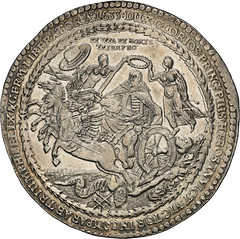

2156710-004. Sweden/Germany. Erfurt. 4 Taler, 1633. Swedish Occupation. Davenport-LS272, Bruun-11899. NGC AU-58.


A0001517289. Denmark. Rose Noble, 1627. Copenhagen Mint. Christian IV. Friedberg-48, Bruun-5504. NGC MS-64
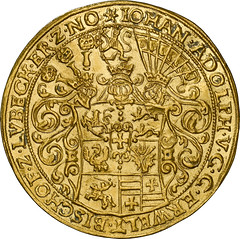
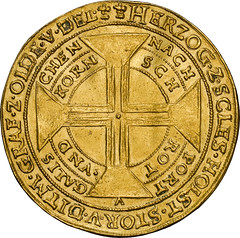
A0001525197. Schleswig-Holstein-Gottorp. 10 Ducats (Portugaloser), No Date. Johann Adolf. Friedberg-1502 var, Bruun-14145. NGC Unc Details.
To read the earlier E-Sylum article, see:
THE BRUUN COLLECTION GETS COVERAGE
(https://www.coinbooks.org/v27/esylum_v27n20a22.html)
STACK'S BOWERS BRUUN COLLECTION PART I
(https://coinbooks.org/v27/esylum_v27n24a16.html)
THE BOOK BAZARRE
WAYNE'S NUMISMATIC DIARY OCTOBER 20, 2024, PART ONE
The months roll by fast. After work on Tuesday, October 15, 2024 I pointed my car to Ristorante Bonaroti in Vienna for the monthly dinner meeting of my Northern Virginia Numismatic Social Group, Nummis Nova. Daryl Haynor was our host and the first member I met upon walking in. As usual we were seated at a long table in the back room and had the room to ourselves.
I sat across from Daryl and between Lorne LaVertu and Jon Radel. Roger Burdette was at the head of our end of the table. Other attendees this month included Steve Bishop, Robert Hoppensteadt, Mike Markowitz, Tom Kays, Julian Leidman and Julian's guest Erik Douglas.
I brought along one book and one medal, shown here atop my menu.
On September 28th I joined a group of neighbors and ran the local "5K on the Runway" race at Dulles Airport. While I'd been a runner in my younger years I was a loner just doing it for fun and exercise. I had only run one other 5K in my life, with a friend visiting from out of town. I'd largely quit running when our kids were young, then resumed for a while when our boys were teens. One day I invited them along and they delighted in showing me up and leaving me in the dust. Discouraged, I pretty much stopped running after that. But one night a year or so ago I had a dream that I'd started running again. The next Saturday while on a morning walk I remembered the dream and ran half a lap around the neighborhood. So I kept it up, and my son Tyler bought me a new pair of running shoes as a present, and I ran nearly once a week after that. When the neighbors started planning the "5K on the Runway", I signed up and started increasing my runs from 2 laps to 3, 4, then 5.
Some 2,000 people participated in the 5 and 10K races. A neighbor drove us in her van. We parked at the National Air and Space Museum, walked thru the museum building and out the other side to a closed runway. United Airlines parked a jet nearby for picture-taking. It was a picture-perfect fall day. I finished 28th in my 61+ age group (I'm 66). It was fun and I proudly wore the medal home.
I'm the cool guy in the middle with shades. I told everyone at dinner that this was my "Yes, as a matter of fact, I DO want a f*&^ing medal."
Back to Nummis Nova - here are my photos from the evening.
Daryl and Roger examine some of the numismatic goodies being passed around the table.
 The Neil Shafer book included some of the notes themselves. Great pairing.
The Neil Shafer book included some of the notes themselves. Great pairing.
The Royal tombs of the Pontic Kings
Robert collects coins with images of ancient architecture. He passed along this image and description of the piece he brought to the meeting. Thanks.
PONTUS. Amasia. Severus Alexander, 222-235. Hexassarion (Bronze, 35 mm, 24.730, CY 228 = 225/6. Laureate, draped and cuirassed bust of Severus Alexander to right, seen from behind. The Akropolis of Amasia: fortified Mount Harsena with temples atop and at the foot; to left of the lower temple, the entrance to the Royal tombs of the Pontic Kings. Dalaison 582 = M&M 333, 1972, 31 = Leu 25, 1980, 374 (this coin). RPC VI online 6467 (this coin is the plate coin.) Very rare and with a fascinating reverse.
Next up is Tom Kays' account of the evening.
To read the earlier E-Sylum article, see:
NEW BOOK: MARYLAND TAMS JOURNAL SPECIAL ISSUE
(https://www.coinbooks.org/v27/esylum_v27n41a06.html)
TOM'S NUMISMATIC DIARY OCTOBER 20, 2024
Tom Kays provided this great write-up of the evening, and the other rare and interesting items passing around the room. Thank you! -Editor
Nummis Nova regulars had to wind our way through the antechambers of Ristorante Bonaroti, an excellent, family-run Italian Restaurant for the past thirty years, where you are treated like royalty and can have a normal, unhurried conversation with your dinner guests. Northern Virginia is quite near to Washington D.C., so that the common area was already stuffed full of famous politicians, former Speakers of the House, senator's wives, and lobbyists all dressed to the nines, whom we had to pass to get back to our exclusive private dining room. Heads must have turned wondering who this mysterious league of scruffy gentlemen in casual, comfortable clothing could be, carrying satchels and briefcases to dinner? We dress informally for fine dining like billionaires do, and not like mere millionaires who worry about making an impression in their stuffy formal attire, still scrounging for that next million. As we take our seats the waiters see us set up all sorts of penlights, tabletop magnifiers, ultra-violet lights, special lenses, analyzers, and assemble makeshift photo stages out of menus and appetizer plates. Perhaps they wonder if we are international diamond merchants?
Clockwise from the left are Steve, Robert, Mike, Daryl, (our sommelier standing), Roger, Jon, Lorne, Erik, and Julian with Wayne and Tom standing out of frame socializing and picture taking.
But then appear ancient gold coins, exotic foreign currency, fine cases holding strange old money, and arcane books with pictures of money on their covers. They must wonder whether we are comptrollers of foreign currency, clandestine Treasury operatives, or mysterious World Bank minions, but hopefully we tip well and not with funny foreign money. Surprise! It is just another Nummis Nova dinner.
To our surprise, Roger Burdette moonlights as an independent playwright, when not in the National Archives searching first-hand accounts of numismatic significance. He brought four of his new theater scripts for our perusal: Twenty-three Seconds, Gig Man, Son of the Morning, and Katz' Kosher Market. At least one of these plays include local references to sites, attractions, and newspaper events in the Washington suburbs of seventy-five years ago. It details how the suburban, mixed use landscape we see today in Montgomery County was once just a dream and far-fetched opportunity. Another of the Nummis Nova regulars knew a real-life land developer of the area who has a highway named after them, who might advise and add truthful color to how business deals were struck back in the day. Again, the waiters really must be wondering who we are, seeing us passing around and discussing thick play scripts and talking stage direction and land development amongst the funny money. We shared typical Nummis Nova dinner talk like how to foil HOA restrictions, meeting Jackie Kennedy at the nude beach, how Silver Spring got its name, the French hornswoggling the English twice for New Orleans, and oh yes, numismatics, including what coins are "Not Collectible" and what the heck am I looking at piling up on my menu including:
• Examples of Samar Province, Philippine Emergency and Guerilla Currency of World War II (Are these a study in ephemera or notaphily?)
• The new Maryland Token and Medal Society (TAMS) Journal - 45 Years Special Issue (1979 – 2024) with many reprints of the best articles
• Billetes Argentinos and Bonos Provinciales (Emergencia) de Argentina along with a binder of thousands of new Chachos having a neat ‘sun rising over mountains' security feature only seen under ultra-violet light in the image on the right
• Unpublished Theater Scripts for Two Act Plays – These are works of fiction, products of the author's imagination, with any resemblance to actual persons, living or dead, or actual events being purely coincidental
• A Severus Alexander ‘City View' Bronze of Pontus Amasia
• A Leo III (the Isaurian) / Constantine V gold Semissis of Constantinople (737 – 741 AD)
• A gold Nine Siliquae (three eighths Solidus or one and a half Scripulum) of Constans Augustus from the Aquileia Mint (340 – 350 AD) – "This is the second known by the way"
• A 15th Annual "5K – 10K on the Runway" Dulles Airport Runners Medal, worn by this famous fellow who on advice from his doctor best make this run the culmination of his athletic running career. Congratulations!
• A 1904 B Edward VII (as King and Emperor) Straits Settlements Dollar in NGC MS-62
• Numismatic Archeology of North America – A Field Guide by Marjorie H. Akin, et.al.
• A WW-II trench art ‘Prisoner of War' bracelet made of 1938 Belgian ten centime pieces
• A George VI (King and Emperor) British India WW-II trench art ‘Prisoner of War' bracelet made of 1942 – 1944 quarter / half / one-rupee pieces
• A copper half penny inscribed with "William Richardson – Carpenter and Swan Appraiser – Newcastle Court – Temple Bar – Funerals Performed" once owned by Chris Eimer
• Other not pictured, finely inscribed gold and silver pieces, corps badges, and awards made from coins that may have been discussed in prior Nummis Nova dinner reports, but who remembers them, so ‘Wow, again.'
As the main course plates were empty and being licked clean (but in a high class manner using bread to sop up the juice), bussed and desserts arrived, I asked Mike how his Cannoli was and he said "It's like meeting God with my tongue." Holy Cannoli! This is fine dining needing no doggy bags, since no leftovers remain. May I highly recommend to you the Ristorante Bonaroti at 428 Maple Avenue East, Vienna, Virginia. Ignore all the famous hoi polloi at the door. Ask for seating in the private "Nummis Nova room" out back for the best fine Italian dining and perhaps you too will be visited by desserts manifesting a religious experience.
WAYNE'S NUMISMATIC DIARY OCTOBER 20, 2024, PART TWO
As Tom noted, although a longstanding low-level pain issue didn't keep me from running the race, a visit to a foot doctor led to his recommendation that I no longer run. I was really bummed out to hear that. I was looking forward to future races. As an official Senior Citizen, the news had an ominous feel - "first they come for your running shoes, then they come for your car keys." It felt like my world was getting smaller, and a reminder that my life was getting shorter. But he said walking was fine for me, so thankfully I can still enjoy that. I didn't run fast anyway.
It was another great night of numismatic fellowship, but my adventure continued with a Newman Numismatic Portal meeting at the S&S Library in Chicago.
The S&S Library
I was back at Dulles airport Friday morning. I parked in the garage for a quick trip. I didn't even take my laptop with me, which is unusual. I traveled light with just a backpack. In addition to a change of clothes I carried a group of material I received from Ed Krivoniak of Pittsburgh. The folders of papers relating to Western Pennsylvania clubs and coin shows will be digitized by NNP.
I also carried a book to read, the new one by NNP friend and numismatic personality interviewer Greg Bennick. I had a couple chapters under my belt before the trip and was halfway thru when I got home. The O'Hare airport Dolly Parton poster echoes one of Greg's themes, the role of kindness.
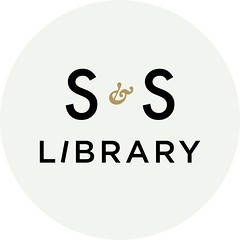 My flight arrived around 9:30am local time and I took an Uber to downtown Chicago. I called Len Augsburger when I entered the lobby of the building housing NBS Board Member Shanna Schmidt's office. An elevator carried me up to the top floor and I joined the meeting in progress. Len was reviewing the history and relationship of the Newman Numismatic Portal and the S&S Library of ancient numismatics, which is shelved in Shanna's office and a separate loft a number of blocks away. Hundreds of books from the library have already been digitized by NNP.
My flight arrived around 9:30am local time and I took an Uber to downtown Chicago. I called Len Augsburger when I entered the lobby of the building housing NBS Board Member Shanna Schmidt's office. An elevator carried me up to the top floor and I joined the meeting in progress. Len was reviewing the history and relationship of the Newman Numismatic Portal and the S&S Library of ancient numismatics, which is shelved in Shanna's office and a separate loft a number of blocks away. Hundreds of books from the library have already been digitized by NNP.
Shanna took a meeting with a client visiting from out of town while the rest of us took a break for lunch. Afterwards we met up with Shanna again at the loft building. Here are some of my photos taken at both locations.
Views outside the downtown office and inside the loft, where the auction catalog section of the BCD Library is stored, now purchased and owned by the S&S Library.
Tyler Rossi and Len Augsburger examine a book.
When I entered the downtown office and sat down in the meeting, my eyes were immediately drawn to some familiar spines - S&S had purchased a number of items from the Kolbe & Fanning sales of my numismatic library, including the Life of Rittenhouse and binders from my numismatic ephemera collection.
One of my favorite items was this pamphlet with a Pittsburgh connection - a transcript of a trial involving a now-rare Civil War scrip note. I once owned what I believe is the only surviving specimen of the note, and wrote an article about it for the journal of the Western Pennsylvania Historical Society.
Before wrapping up our visit we were treated to a delightful piano performance by Shanna and Len. The NNP folks and I walked to a nearby bar for an outdoor Happy Hour discussion. After we broke up and went our separate ways I walked the neighborhood a bit and stopped in another bar for a sandwich and beer while I plowed thru the day's email on my phone. After another Uber ride I was at my hotel, the Crowne Plaza O'Hare Airport in Rosemont (where I'd stayed for this year's ANA convention). After breakfast their shuttle got me to the airport with an hour to spare.
It was a quick but rewarding trip. It was great to visit with everyone, see an absolutely overwhelming numismatic library, take care of some NNP business, and stroll down Memory Lane with some of my former library material. I'm happy they've found an illustrious new home - they're in good hands now.
To read the earlier E-Sylum articles, see:
BCD CATALOGS ARRIVE IN CHICAGO
(https://www.coinbooks.org/v26/esylum_v26n52a07.html)
https://www.coinbooks.org/v26/esylum_v26n39a09.html
(https://www.coinbooks.org/v26/esylum_v26n39a09.html)
S&S LIBRARY UPDATE
(https://www.coinbooks.org/v27/esylum_v27n09a08.html)
1913 GOLD CARNEGIE HERO FUND MEDAL
In their November 2024 Showcase Auction, Stack's Bowers is offering a rare gold Carnegie Hero medal. -Editor
(1913) Carnegie Hero Fund Medal. Gold. Awarded to Julius B. Gordon. Mint State, Engraving Effaced.
76 mm. 10.8 ounces, .999 fine, 9.84 troy ounces AGW. Marked on the edge at 6 o'clock 24 K J.E. CALDWELL & CO. PHILA. PAT. DEC. 11. '06. These important medals - the civilian equivalent to the Congressional Medal of Honor - were first awarded in 1904. On March 12 of that year Andrew Carnegie began a Hero Fund commission in Philadelphia to recognize acts of bravery by ordinary Americans. Between 1904 and 2015 the Fund awarded 9,975 medals (and they continue to do so) but, while initially awarded in gold, silver and bronze, the vast majority have been in bronze. Rising precious metals costs forced the elimination of the gold award after only 19 were distributed, the last to Charles L. Coe of Burkburnett, Texas, who died in a fire rescue act in 1923. The silver award followed suit in 1981, after 617 had been distributed, the last to Brian Mervyn Clegg and Robert Stephen Grant for rescue acts performed in 1979.
While we have handled numerous bronze examples over the years, not surprisingly given their high distribution, our online archives back to 2009 include only three different silver examples, awarded in 1907, 1909 and 1920. This is the first gold award medal that we can recall offering, and it is a particularly intriguing specimen. While clearly an awarded example, the inscription to the recipient on the cartouche has been almost completely effaced by numerous tiny digs that, when viewed as a whole, provide a stippled effect to the surface in that area. Close inspection of the penultimate line in the inscription with a loupe, however, reveals traces of the following letters: ER CK OKLA. These are the letters for Frederick, Oklahoma. The third-to-last and penultimate gold Carnegie medals were awarded in 1913 to residents of Frederick, Oklahoma - Charles Zolninger and Julius B. Gordon - for helping to rescue Oliver H. Brewer and Alvah Dean from a cave-in in a well in that town on October 28, 1913. Zolninger and Gordon also received a money award. Two other men (William H. Reed, Sr. and John F. Steinbock) received silver medals and a sum of money for the same rescue.
This is the medal awarded to Julius B. Gordon, and it is identifiable as such by a remnant of the bottom curve of the letter J in his first name below the concentration of tiny digs effacing the inscription at upper left. While technically Mint State, the effacement of the inscription is obviously a significant detraction, and we can only guess as to why it was done. Additionally, there are several fine grazes and nicks to the delicate sand blast finish on both sides, and a couple of minor edge nicks at 7 o'clock on the reverse. The medal is accompanied by the original black leather, green plush interior case of issue from J.E. Caldwell & Co., which is quite tattered, yet complete with a barely functional clasp. Also included in this lot is a research file of printed materials pertaining to the gold Carnegie award medals in general, as well as some biographical information on Julius B. Gordon. (Total: 1 medal; 1 case; 1 document file)
Nice detective work, and the question remains - why would anyone ever do such a thing to a medal? What a shame for a rare, important piece to receive such treatment. But it's still an important rarity with a story to tell. -Editor
To read the complete article, see:
(1913) Carnegie Hero Fund Medal. Gold. Awarded to Julius B. Gordon. Mint State, Engraving Effaced.
(https://auctions.stacksbowers.com/lots/view/3-1E2WQO/1913-carnegie-hero-fund-medal-gold-awarded-to-julius-b-gordon-mint-state-engraving-effaced)
MASSACHUSETTS RAILROAD STOCK CERTIFICATES
We recently discussed ScripoTime, a new site for collectors of stock certificates and other financial documents. With permission, we're excerpting one of the articles, originally written and published by G.Labarre in The LaBarre Newsletter, Issue 1, Winter 1981. Thanks. -Editor
Stock and bond certificates and shares are more than mere representations of wealth or financial gain. More than that, they are reflections of human endeavor, industrial expansion and the growth of this nation. Each has its own unique and fascinating story to tell. With those important points in mind, it is both interesting and useful for collectors and investors to be aware of historical background of companies that have issued stocks or bonds to finance their development and growth. This first issue of the "Stock and Bond Investment Quarterly" will discuss a perennial favorite of many types of collectors; railroad companies.
Taunton Branch Railroad Company, Massachusetts
This company was incorporated in April 1835, to construct a railroad from Taunton to Mansfield on the Boston and Providence line. Construction began that year, and was completed in August 1836. On July 2, 1840, the New Bedford and Taunton Railroad was completed, and connected with the Taunton Branch. Both railroads operated under the same management.
The original issue of capital stock amounted to $250,000 for the Taunton Branch. Actual construction costs overran that amount slightly at about $256,000. The line was short, running just over eleven miles. The railroad began paying dividends three years after completion, and within six years was paying a tidy six percent return on investment, a rate it was able to maintain for a number of years.
Fall River Railroad Company, Massachusetts
This particular railroad was formed by the consolidation of three separate lines: the Fall River Branch, the Middleboro, and the Randolph and Bridgewater Companies. The Fall River Branch was incorporated in March 1844, to construct a line from Fall River to Myrick's Station. Both the Middleboro and the Randolph and Bridgewater Companies were formed in March 1845, the former to construct a railroad from Bridgewater to the Fall River Branch at Myrick's Station, and the latter to build a line from Bridgewater to the Old Colony Railroad in Braintree. The three merged in August 1845, following the successful completion of their respective segments of the entire line. In April of the following year, the merger was granted official sanction by an act passed by the state legislature.
Share capital of the three companies totaled slightly over $1,000,000, a significant investment for that era. Construction of the entire line to its junction with the Old Colony was completed in December 1846. The entire line covered forty-two miles. Nearly a decade later in 1854, the Fall River and Old Colony Lines were consolidated, thus forming the Old Colony and Fall River Railroad.
To read the complete article, see:
Historical Notes
(https://scripotime.com/historical-notes-2/)
To visit the LaBarre website, see:
https://www.glabarre.com/
To visit the ScripoTime website, see:
https://scripotime.com/
To read the earlier E-Sylum article, see:
FEATURED WEBSITE: SCRIPOTIME
(https://www.coinbooks.org/v27/esylum_v27n38a33.html)
LOOSE CHANGE: OCTOBER 20, 2024
Here are some additional items in the media this week that may be of interest. -Editor
An article by Ursula Kampmann on behalf of Künker examines numismatic testaments to the consecration of Roman Emperors. -Editor
Vae, puto deus fio – oh dear, I think I'm becoming a god, Vespasian is said to have joked when he experienced the first symptoms of the disease that would kill him later. Actually, it might be the case that Suetonius was indulging in anachronism at this point. After all, at the time of Vespasian's death in 79 AD, it was not as common for members of the imperial family to be deified as it was when Suetonius died in 122. Between the deaths of Augustus and Vespasian, only one emperor was divinized: Claudius. And Seneca's Apocolocynthosis gives us an idea of how weird his contemporaries found this practice: the title Apocolocynthosis is based on the Roman term for deification (apotheosis), and it refers to something being transformed into a pumpkin.
It was not until Titus and his brother Domitian that the deification of one's ancestors was systematically used as a political means by the emperors. To establish this practice as a ritual, they took their inspiration from the deification of Augustus.
To read the complete article, see:
Oh Dear, I Think I'm Becoming a God! Numismatic Testaments to the Consecration of Roman Emperors
(https://www.kuenker.de/de/information/presseinformationen/aktuelle-mitteilungen/595)
Pablo Hoffman passed along this recent Delancey Place article about the creation of the Euro. Thanks. -Editor
 Today's selection-- from Europe Recast by Desmond Dinan. The radical idea of a common European currency as it emerged in the 1980s through a bewildering array of ideas and institutions including the European Monetary System, the European Community (the executive branch of the European Union), and the European Monetary Union
Today's selection-- from Europe Recast by Desmond Dinan. The radical idea of a common European currency as it emerged in the 1980s through a bewildering array of ideas and institutions including the European Monetary System, the European Community (the executive branch of the European Union), and the European Monetary Union
To read the complete article, see:
the birth of the euro--10/8/24
(https://delanceyplace.com/view-archives.php?p=5137)
In an auction this week, a rare early printing of the U.S. Constitution was sold, having been found in the home of North Carolina's Governor at the time. -Editor
A rare copy of the United States Constitution that was printed shortly after the Constitutional Convention in 1787 and played a role in the document's adoption by the original 13 states sold for more than $11 million during a live auction on Thursday evening.
The copy of the Constitution was found two years ago in a filing cabinet in the house at Hayes, a farm once owned by Samuel Johnston, who served as governor of North Carolina from December 1787 to December 1789. The document's discovery garnered national attention for being an early copy of the document and for the role it played in the document's ratification.
After the Constitutional Convention and after Congress added a ratification resolution, copies were sent to the governors of the original 13 states, who then gauged interest among their residents. Among those copies was the one sold on Thursday.
To read the complete article, see:
Rare Copy of U.S. Constitution Sells for More Than $11 Million
(https://www.nytimes.com/2024/10/19/us/us-constitution-copy-sold.html)







